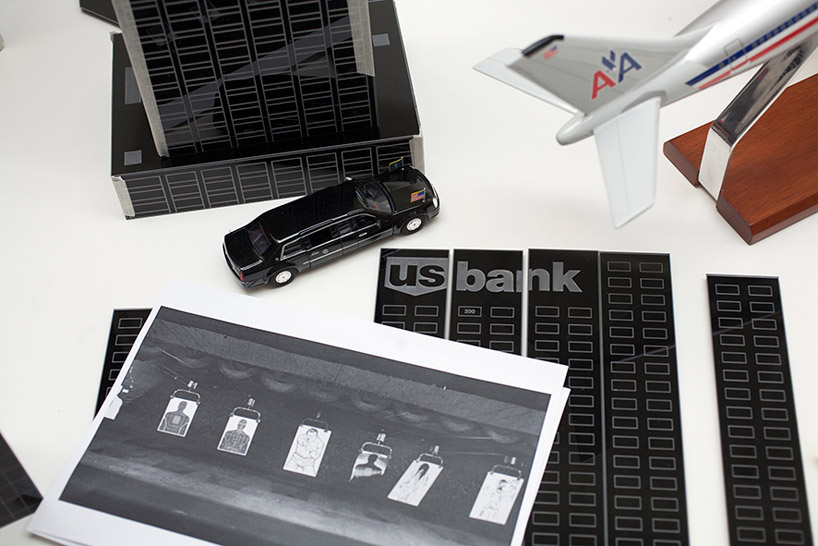
Želiteli podržati umjetnički projekt savršene pljačke banke?
www.ilonagaynor.co.uk/
vimeo.com/gaynoir/videos
twitter.com/no_dept
My guest tomorrow will be Ilona Gaynor and she'll be talking to us about forensic science, police reconstructions and the not so technically sophisticated (but very smart) way to rob a bank in broad day light on Wilshire Boulevard in Los Angeles. Ilona is a young artist and designer who got the attention of the press - from blogs to the Financial Times- in 2011 for her RCA graduation project Everything Ends in Chaos. The work explored economics, finance, global markets, risk management, insurance and mathematics.
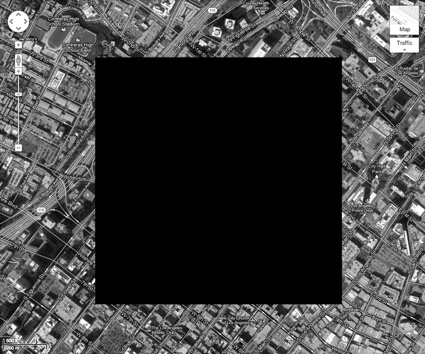
Downtown Los Angeles, 20x20m Block
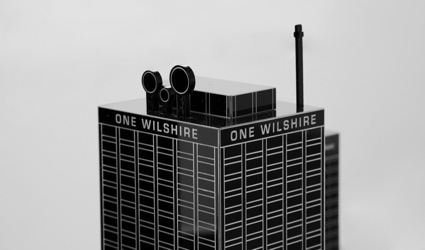
Scale Model, One Wilshire
Over the past 2 years, however, Ilona has been working on Under Black Carpets. The research project is a thorough investigation and planning of the robbery of 5 of the richest banks located in downtown LA. Posing as a LAPD officer, Ilona has researched not only how to 'investigate, intervene and be forceful' but also how to efficiently rob banks.
Ilona Gaynor also runs the design and research practice The Department of No.
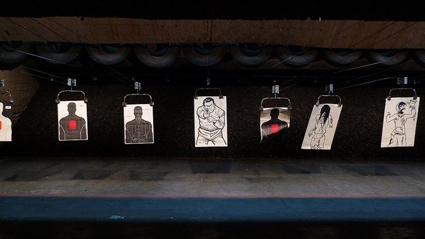
Los Angeles Police Academy. Training ground
The show will be aired this Wednesday 3rd of July at 16:00, London time. Early risers can catch the repeat next Tuesday at 6.30 am (I know...) If you don't live in London, you can listen to the online stream or wait till we upload the episodes on soundcloud.

Everything Ends in Chaos
Everything Ends In Chaos is a mixed-media collection of objects, narrative texts and films that reveal the intricate trajectories of an artificially designed and then reverse engineered, economically viable Black Swan event.
As functioning humans beings, psychologically we are collectively and individually blind to uncertainty, and therefore often unaware of the impact that singular events can have on our lives: economically, historically and scientifically, until after their occurrence. Some of us die by this mistake and some of us profit beyond our wildest dreams from it.
Everything Ends in Chaos is a project that’s attempt is to artificially construct a financial Black Swan. Positioned in hindsight, and told through a series of fragmented hypothetical narratives that have undergone various actuary financial assessments; made by investment bankers and insurance brokers to loss adjusters and risk strategists, drawing upon the practice of insurance with the means to investigate and underpin the moment at which economical fact becomes fiction and vise versa.
The plot begins with the kidnapping of a Mrs Henderson, wealthy wife of a senator, who's stolen diamonds proceed to the unfolding of an extremely complex series of tipping points that lead to an actuary economically viable, global financial meltdown.
Can we really insure for such unpredictability?
What does an economic collapse actually look like?
How might it feel to witness such chaos?
Everything will end in chaos, but let’s hope that it be a deliciously, catastrophically beautiful and chaotically profitable, blackest of Black Swans.
THE PLOT
The plot begins with the kidnapping of a Mrs Henderson. Being the wealthy wife of a senator, her Mercedes is stopped on route 87, crossing the Arizona State desert in a vicious attack. She is kidnapped and held for ransom.
Following the procedure of ransom as a demand, the kidnappers cut the wife's left ring finger off (ring still attached) and send it to the family's insurance broker via FedEx's special delivery service. She is stripped of her immediate items of worth: earrings, cellphone, gold watch and more notably her diamond necklace given to her by husband, upon the approach of their diamond wedding anniversary.
Her knecklace is dismantled and the stones force-fed to a rare flock of Eurasian Collared doves, ready for smuggling out of the United Stated via the airport.
Upon delivery of the package containing Mrs Henderson's finger, the FedEx delivery truck driver is distracted and crashes spilling its contents into the road, causing a pile up and delaying the delivery of the ransom demand.
The birds whilst on route to the the airport, via limousine (to serve for the sake of a keeping up of appearence) the cage used to hold the flock is dislodged, allowing the doves escape, the precious stones still lodged in their bellies. -www.ilonagaynor.co.uk/Everything_Ends_In_Chaos/
Film: vimeo.com/25480554
As functioning humans beings, psychologically we are collectively and individually blind to uncertainty, and therefore often unaware of the impact that singular events can have on our lives: economically, historically and scientifically, until after their occurrence. Some of us die by this mistake and some of us profit beyond our wildest dreams from it.
Everything Ends in Chaos is a project that’s attempt is to artificially construct a financial Black Swan. Positioned in hindsight, and told through a series of fragmented hypothetical narratives that have undergone various actuary financial assessments; made by investment bankers and insurance brokers to loss adjusters and risk strategists, drawing upon the practice of insurance with the means to investigate and underpin the moment at which economical fact becomes fiction and vise versa.
The plot begins with the kidnapping of a Mrs Henderson, wealthy wife of a senator, who's stolen diamonds proceed to the unfolding of an extremely complex series of tipping points that lead to an actuary economically viable, global financial meltdown.
Can we really insure for such unpredictability?
What does an economic collapse actually look like?
How might it feel to witness such chaos?
Everything will end in chaos, but let’s hope that it be a deliciously, catastrophically beautiful and chaotically profitable, blackest of Black Swans.
THE PLOT
The plot begins with the kidnapping of a Mrs Henderson. Being the wealthy wife of a senator, her Mercedes is stopped on route 87, crossing the Arizona State desert in a vicious attack. She is kidnapped and held for ransom.
Following the procedure of ransom as a demand, the kidnappers cut the wife's left ring finger off (ring still attached) and send it to the family's insurance broker via FedEx's special delivery service. She is stripped of her immediate items of worth: earrings, cellphone, gold watch and more notably her diamond necklace given to her by husband, upon the approach of their diamond wedding anniversary.
Her knecklace is dismantled and the stones force-fed to a rare flock of Eurasian Collared doves, ready for smuggling out of the United Stated via the airport.
Upon delivery of the package containing Mrs Henderson's finger, the FedEx delivery truck driver is distracted and crashes spilling its contents into the road, causing a pile up and delaying the delivery of the ransom demand.
The birds whilst on route to the the airport, via limousine (to serve for the sake of a keeping up of appearence) the cage used to hold the flock is dislodged, allowing the doves escape, the precious stones still lodged in their bellies. -www.ilonagaynor.co.uk/Everything_Ends_In_Chaos/
Film: vimeo.com/25480554
The title of the project that Ilona Gaynor presented at the Idea in Progress show at the RCA, London a few weeks ago could be applied to almost every single story that graces newspaper front pages nowadays. I've actually stopped counting the times the word 'chaos' has been used in connection with unrest in the Middle East and North Africa. What surprises me is how often the news of ongoing 'chaos' in Libya or Egypt is associated with 'Western' fears of a rise of oil prices or spike in immigration numbers.
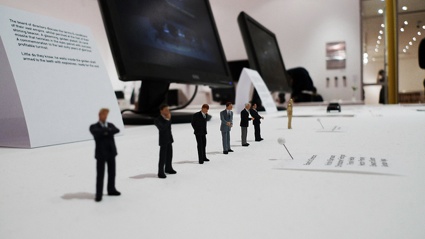
Image Ilona Gaynor
Everything Ends in Chaos fascinated me because it is somehow related to all of the above and much more. The project attempts to design, then reverse engineer a single, spectacular Black Swan event. Black Swan events are unpredicted but of such magnitude that they have an important impact on history. Nassim Nicholas Taleb exposed this theory in 2007, in a book that has been credited with predicting the banking and economic crisis of 2008. According to Taleb, the rise of the Internet, World War I, and the September 11 attacks as examples of Black Swan Events.
Ilona's research topic is ambitious, it spans economics, finance, global markets, risk management, insurance and mathematics. I aim to explore the paradoxical nature of policy by examining and speculating on the 'invisible' negotiations and momentary instances that affect, compromise and twist policy for means of financial and / or political gain as well as its implications.
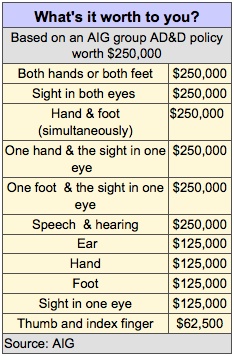 What are your body parts worth? By Insure.com, Dec. 7, 2009
What are your body parts worth? By Insure.com, Dec. 7, 2009
For the work in progress show at the RCA, Ilona presented two fictional scenarios that intertwine real documents revealing actual insurance practices (such as the existence of kidnap and ransom insurance, of dismemberment insurance and charts listing the worth of your body parts, etc.) with imaginary stories. The result is an exploration of the seemingly fictional paradoxes that could occur and unfold as a result of precautionary bureaucratic policies.
Follow the project on twitter!
Could you take us through the scenarios? In the first one a bomb is hidden inside golden trophy hangs above the heads of directors in a boardroom. In the second scenario, the wife of a rich insurance broker is kidnapped. What lies behind those snapshots of the whole story? How are both scenarios related to one another?
Ilona Gaynor: The first scenario takes place within a boardroom at an underwriters firm called A-Corporation, the firm specialises in the insurance of military assets, from missiles to the transportation of assets between geographical borders. The 24 carat golden missile that hangs so delicately above their head's, was commissioned and hung by the CEO of A-Corporation as a commemoration, a beacon of hope, and inspiration, a celebration for the last profitable decade of underwritten contracts. There are 6 board members that sit within this room, all of whom are exceptionally well paid and each have a severance contract attached to their position within the company. A-Corporation is considering a merger and through its decision decides to blow up the boardroom, with the intention of killing its 6 board members, and therefore rendering the severance agreements null in void.
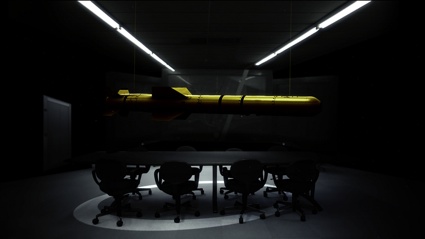
A-Corporations Board Room (scenario film still). Image Ilona Gaynor
The second scenario takes place around a family called the Henderson's. Mrs Daphne Henderson is the wife of Frank Henderson, a wealthy senator. Mrs Henderson is kidnapped. She was taken from their family Mercedes state car on a highway in Arizona, which the kidnappers mistook for the Senators motorcade vehicle. The kidnappers cut off her wedding ring finger and sent it via FedEx to the Henderson's family Insurance broker Mr Bowery of Hiscox, along with their ransom demands. Upon receiving her finger, the broker was ordered by the senator for the ransom money to be sent immediately. In the expecting return of Mrs Henderson, the senator decided to throw a small party to welcome her back to their home. Not knowing how hideously disfigured she might be, he took the liberty of inviting their plastic surgeon.
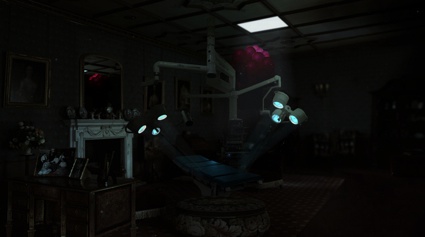
Welcome home party at Henderson Manor (scenario film still). Image Ilona Gaynor
In the exhibition the two video scenarios were accompanied by various artefacts relating to each of the stories. The artefacts are made up of designed and doctored legal contracts, mostly insurance related to pull the fiction back into the reality. The contracts, fine prints and stock snapshots are offered up to the audience as evidence, physical coordinates that lead to and highlight the very real motives involved and reveal the benefactors. The scenarios will eventually relate to each other in a larger narrative, made up of a series, 5 events to be exact.
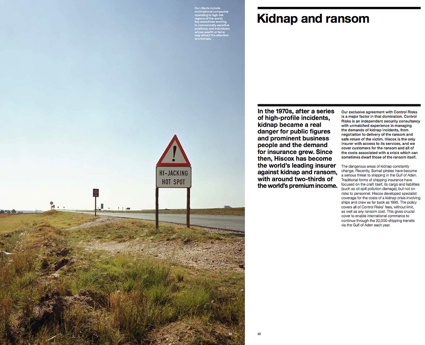
Pages from The Hiscox Corporate Brochure 2009. Image Ilona Gaynor
Your scenarios are fictional but how do they relate exactly to the current economic situation? Do they have relevance on a global level or do they mostly apply to the UK situation?
Ilona Gaynor: Over the last 3 years, we have all been confronted by a global economic crisis. It seems to be all too easy to critically attack and lay blame to bankers, market traders and corporations.
Ilona Gaynor: I think the role of designers in economics is crucial and could be one of reflection and scenario based strategy. It is becoming more evident that the role of human behaviour in systems design, particularly those designed to monopolize tends to be neglected. Human nature makes mistakes, not the machines. How could we possibly manage risk without the acknowledgment of this key factor? Design has the power to stimulate the imagination and make abstract issues tangible. If we can use speculative design proposals to imagine alternative trajectories and reflect upon current methodologies, it might allow us to open up a meaningful debate before policies are written. Designers have been starting to contribute to many important fields for years, from medicine to politics. I don't see why economics should be any different.
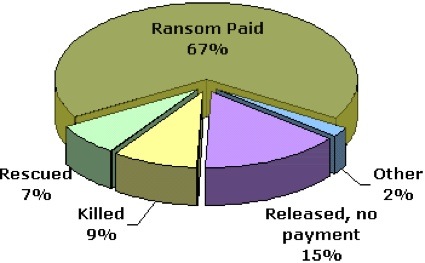
Coverage Kidnap, Ransom and Detention Insurance has secretly existed for many years. Petersen have determined that the public needs to know about this valuable coverage. International Kidnap/Detention and Crisis Assistance Coverage provides easy access and implementation
The project looks very cynical to me. The title itself is fairly daunting. What is the critical discourse behind the project? Do you really have such a dark view of economics?
Ilona Gaynor: I have a dark view of most things, but unlike most I don't think it's a bad thing... the world makes more sense in the dark... it's when it's viewed in the light that we should be worried. Economics, I don't think is necessarily so sinister... the Vatican for example is probably more riddled with corruption, scandal and greed then the banking sector. But I do think that as its complexity continues to grow and get increasingly denser, it starts to tangle and knots occur. It's becoming more and more difficult to control such a living organism and I don't think we can continue down a pathway that's so obviously treacherous. The critical discourse lies in my aim to celebrate such a system. It's a non-human entity with non-human goals, and it's deliciously destructive. It was designed for one thing only - to make a profit. The seduction is obvious, you only have to witness Oliver Stone's Gordon Gekko to empathise with such a honey trap.
We can do one of two things: we can witness it unravel and enjoy the complicated pleasure accepting that "greed is good", or we can move towards a rethink of how we design economic and financial systems.
EEIC is still a work in progress. How much research do you still have to do? And where do you think that it will lead you to?
Ilona Gaynor: The research will always be ongoing, I think it's important that the dialogue between the economics and finance communities and myself continues to be ongoing and stays strong.
But my quest overall, is to design and then communicatively reverse engineer a singular 'Black Swan' event. The work in progress (for the show in particular) was more of an exercise in communicating such complex abstract narratives viscerally. I intend to write a further three scenarios, drawing on the emphasis of which is to highlight the principal of cause and affect. The final project will take the form of films (five in total). The stories will highlight linchpin key moments that will merge to become a hypothetical Black Swan event.
A second layer to the project will then be an assessment made by five legitimate insurance underwriters. This will be carried out to determine how much actual profit (written in insurance premiums and contracts) in monetary terms is extractable from my hypothetical scenarios. Can we really insure for the highly unexpected? How much money is a chaotic collapse actually worth? Who might be the winner? And Is this something to aspire to?

Gordon Gekko. Still from the movie Wall Street
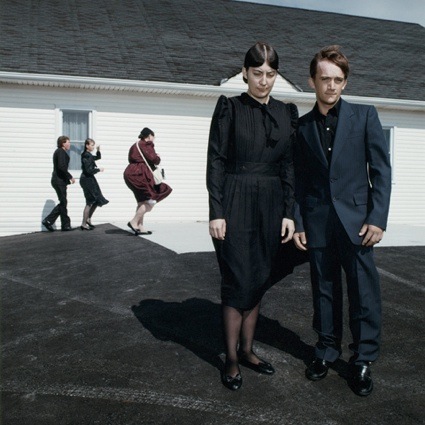
Morad Bouchakour, Ontario Canada, from the series Mexican Mennonites
I saw on your flickr set that you did some research to create a precise aesthetics for the project. What kind of feeling and ideas does this aesthetics try to convey?
Ilona Gaynor: The aesthetics need to be precise enough to pull you into a world. I'm interested in drawing upon the hyper-real, something that could be deemed uncanny, to reflect the hypothetical absurd nature of the world we are looking down upon. I want the audience to experience something voyeuristic, as if you were that third person in the scene, totally absent from participation but free to stand, observe and smirk... 'There's an elephant in the room and no one can see it but me'.
To give a sense of place, to me is thrilling. Places are made up of a very fluent language of detail and are therefore incredibly important and necessary in allowing you to dream and speculate beyond four walls. Taking into account color, perspectives, shape and texture... if all those things are correct and something catches your eye in certain way, with a certain kind of light and the right subtle movement you're gone, you're in heaven. I think the world I'm playing in is so distinctly un-explored, you can't go in and film it, unless you first build it first.
Thank you Ilona!
Other project from Design Interactions' latest work in progress show: Known Unknowns and BACK, HERE BELOW, FORMIDABLE [ the rebirth of prehistoric creatures ].
Credit image on the homepage: Dunne and Raby.
- we-make-money-not-art.com/


Image Ilona Gaynor
Everything Ends in Chaos fascinated me because it is somehow related to all of the above and much more. The project attempts to design, then reverse engineer a single, spectacular Black Swan event. Black Swan events are unpredicted but of such magnitude that they have an important impact on history. Nassim Nicholas Taleb exposed this theory in 2007, in a book that has been credited with predicting the banking and economic crisis of 2008. According to Taleb, the rise of the Internet, World War I, and the September 11 attacks as examples of Black Swan Events.
Ilona's research topic is ambitious, it spans economics, finance, global markets, risk management, insurance and mathematics. I aim to explore the paradoxical nature of policy by examining and speculating on the 'invisible' negotiations and momentary instances that affect, compromise and twist policy for means of financial and / or political gain as well as its implications.
 What are your body parts worth? By Insure.com, Dec. 7, 2009
What are your body parts worth? By Insure.com, Dec. 7, 2009For the work in progress show at the RCA, Ilona presented two fictional scenarios that intertwine real documents revealing actual insurance practices (such as the existence of kidnap and ransom insurance, of dismemberment insurance and charts listing the worth of your body parts, etc.) with imaginary stories. The result is an exploration of the seemingly fictional paradoxes that could occur and unfold as a result of precautionary bureaucratic policies.
Follow the project on twitter!
Could you take us through the scenarios? In the first one a bomb is hidden inside golden trophy hangs above the heads of directors in a boardroom. In the second scenario, the wife of a rich insurance broker is kidnapped. What lies behind those snapshots of the whole story? How are both scenarios related to one another?
Ilona Gaynor: The first scenario takes place within a boardroom at an underwriters firm called A-Corporation, the firm specialises in the insurance of military assets, from missiles to the transportation of assets between geographical borders. The 24 carat golden missile that hangs so delicately above their head's, was commissioned and hung by the CEO of A-Corporation as a commemoration, a beacon of hope, and inspiration, a celebration for the last profitable decade of underwritten contracts. There are 6 board members that sit within this room, all of whom are exceptionally well paid and each have a severance contract attached to their position within the company. A-Corporation is considering a merger and through its decision decides to blow up the boardroom, with the intention of killing its 6 board members, and therefore rendering the severance agreements null in void.

A-Corporations Board Room (scenario film still). Image Ilona Gaynor
The second scenario takes place around a family called the Henderson's. Mrs Daphne Henderson is the wife of Frank Henderson, a wealthy senator. Mrs Henderson is kidnapped. She was taken from their family Mercedes state car on a highway in Arizona, which the kidnappers mistook for the Senators motorcade vehicle. The kidnappers cut off her wedding ring finger and sent it via FedEx to the Henderson's family Insurance broker Mr Bowery of Hiscox, along with their ransom demands. Upon receiving her finger, the broker was ordered by the senator for the ransom money to be sent immediately. In the expecting return of Mrs Henderson, the senator decided to throw a small party to welcome her back to their home. Not knowing how hideously disfigured she might be, he took the liberty of inviting their plastic surgeon.

Welcome home party at Henderson Manor (scenario film still). Image Ilona Gaynor
In the exhibition the two video scenarios were accompanied by various artefacts relating to each of the stories. The artefacts are made up of designed and doctored legal contracts, mostly insurance related to pull the fiction back into the reality. The contracts, fine prints and stock snapshots are offered up to the audience as evidence, physical coordinates that lead to and highlight the very real motives involved and reveal the benefactors. The scenarios will eventually relate to each other in a larger narrative, made up of a series, 5 events to be exact.

Pages from The Hiscox Corporate Brochure 2009. Image Ilona Gaynor
Your scenarios are fictional but how do they relate exactly to the current economic situation? Do they have relevance on a global level or do they mostly apply to the UK situation?
Ilona Gaynor: Over the last 3 years, we have all been confronted by a global economic crisis. It seems to be all too easy to critically attack and lay blame to bankers, market traders and corporations.
I think it's more important if not more interesting to contextualise and frame the infrastructure that was able to facilitate such media projected 'atrocities' and make sense of something that has such impact on our lives and our future. The scenarios are hypothetical, an exaggerated microscopic look at a system that exists within our proximity, that often goes fairly un-noticed, or is deemed too complex to be understood. My research for this project has led to such potent content; that moving beyond the 'highlighting illustrative' and pushing it into the designed hypothetical is really important. We can all relate to insurance and the frustrating paradoxes that crop up within mundane bureaucracy, but we might not all be aware of the circumstances that need to occur in order for the various systems in play to spit out a sizeable profit.
EEIC deals with economic policy. What could be the role of a designer in the context of economics?Ilona Gaynor: I think the role of designers in economics is crucial and could be one of reflection and scenario based strategy. It is becoming more evident that the role of human behaviour in systems design, particularly those designed to monopolize tends to be neglected. Human nature makes mistakes, not the machines. How could we possibly manage risk without the acknowledgment of this key factor? Design has the power to stimulate the imagination and make abstract issues tangible. If we can use speculative design proposals to imagine alternative trajectories and reflect upon current methodologies, it might allow us to open up a meaningful debate before policies are written. Designers have been starting to contribute to many important fields for years, from medicine to politics. I don't see why economics should be any different.

Coverage Kidnap, Ransom and Detention Insurance has secretly existed for many years. Petersen have determined that the public needs to know about this valuable coverage. International Kidnap/Detention and Crisis Assistance Coverage provides easy access and implementation
The project looks very cynical to me. The title itself is fairly daunting. What is the critical discourse behind the project? Do you really have such a dark view of economics?
Ilona Gaynor: I have a dark view of most things, but unlike most I don't think it's a bad thing... the world makes more sense in the dark... it's when it's viewed in the light that we should be worried. Economics, I don't think is necessarily so sinister... the Vatican for example is probably more riddled with corruption, scandal and greed then the banking sector. But I do think that as its complexity continues to grow and get increasingly denser, it starts to tangle and knots occur. It's becoming more and more difficult to control such a living organism and I don't think we can continue down a pathway that's so obviously treacherous. The critical discourse lies in my aim to celebrate such a system. It's a non-human entity with non-human goals, and it's deliciously destructive. It was designed for one thing only - to make a profit. The seduction is obvious, you only have to witness Oliver Stone's Gordon Gekko to empathise with such a honey trap.
We can do one of two things: we can witness it unravel and enjoy the complicated pleasure accepting that "greed is good", or we can move towards a rethink of how we design economic and financial systems.
EEIC is still a work in progress. How much research do you still have to do? And where do you think that it will lead you to?
Ilona Gaynor: The research will always be ongoing, I think it's important that the dialogue between the economics and finance communities and myself continues to be ongoing and stays strong.
But my quest overall, is to design and then communicatively reverse engineer a singular 'Black Swan' event. The work in progress (for the show in particular) was more of an exercise in communicating such complex abstract narratives viscerally. I intend to write a further three scenarios, drawing on the emphasis of which is to highlight the principal of cause and affect. The final project will take the form of films (five in total). The stories will highlight linchpin key moments that will merge to become a hypothetical Black Swan event.
A second layer to the project will then be an assessment made by five legitimate insurance underwriters. This will be carried out to determine how much actual profit (written in insurance premiums and contracts) in monetary terms is extractable from my hypothetical scenarios. Can we really insure for the highly unexpected? How much money is a chaotic collapse actually worth? Who might be the winner? And Is this something to aspire to?

Gordon Gekko. Still from the movie Wall Street

Morad Bouchakour, Ontario Canada, from the series Mexican Mennonites
I saw on your flickr set that you did some research to create a precise aesthetics for the project. What kind of feeling and ideas does this aesthetics try to convey?
Ilona Gaynor: The aesthetics need to be precise enough to pull you into a world. I'm interested in drawing upon the hyper-real, something that could be deemed uncanny, to reflect the hypothetical absurd nature of the world we are looking down upon. I want the audience to experience something voyeuristic, as if you were that third person in the scene, totally absent from participation but free to stand, observe and smirk... 'There's an elephant in the room and no one can see it but me'.
To give a sense of place, to me is thrilling. Places are made up of a very fluent language of detail and are therefore incredibly important and necessary in allowing you to dream and speculate beyond four walls. Taking into account color, perspectives, shape and texture... if all those things are correct and something catches your eye in certain way, with a certain kind of light and the right subtle movement you're gone, you're in heaven. I think the world I'm playing in is so distinctly un-explored, you can't go in and film it, unless you first build it first.
Thank you Ilona!
Other project from Design Interactions' latest work in progress show: Known Unknowns and BACK, HERE BELOW, FORMIDABLE [ the rebirth of prehistoric creatures ].
Credit image on the homepage: Dunne and Raby.
- we-make-money-not-art.com/

Everything Ends in Chaos, Est 1703
Written by (Ilona Gaynor) 2011
This book is a collated research document, displaying the artifacts and selective research that has contributed to and led the direction of my enquiry for the project entitled ‘Everything Ends in Chaos’ – my final graduation project, whilst studying in the Design Interactions department at the Royal College of Art.
For more information about the project, visit Everything Ends in Chaos
Written by (Ilona Gaynor) 2011
This book is a collated research document, displaying the artifacts and selective research that has contributed to and led the direction of my enquiry for the project entitled ‘Everything Ends in Chaos’ – my final graduation project, whilst studying in the Design Interactions department at the Royal College of Art.
For more information about the project, visit Everything Ends in Chaos





Excerpt Insurance is often associated with drab, mundane office spaces lined with polyester gray carpets, stale water coolers and stained coffee cups. The series of images that follow are images that describe a different aesthetic, one I imagine could be conjured as a result of policy. What does a Black Swan really look like? How might it feel to be situated within it or even standing by the sidelines watching it and how might the policy describe the event?
Paradoxically insurance is as much about fantasy as it is about reality, how do we imagine speculative risk? What might it look like? Could it look like scene from a Kubrick film, or might the people involved converse like characters in a Coen film? Policies can be read as fiction, because that is exactly what they are until the speculation becomes true.
© Ilona Gaynor 2011
Written by: Ilona Gaynor
Design: Gabriele Weichert
Photography: Ilona Gaynor, various materal sources
Paradoxically insurance is as much about fantasy as it is about reality, how do we imagine speculative risk? What might it look like? Could it look like scene from a Kubrick film, or might the people involved converse like characters in a Coen film? Policies can be read as fiction, because that is exactly what they are until the speculation becomes true.
© Ilona Gaynor 2011
Written by: Ilona Gaynor
Design: Gabriele Weichert
Photography: Ilona Gaynor, various materal sources

120 Seconds of A Future
120 Seconds of Future, is film that depicts
a vision of excessive wealth and unapologetic
decadence.
It's easy to imagine a future where our closest
experience to nature: parks, forests, gardens and general
plant life, will become increasingly less accessible to
the point of near extinction, due to excessive technological
and industrial visions of progress. To 'experience' nature
will become that of a rarity and therefor solely exclusive
to the rich and powerful.
120 Seconds of Future, is film that depicts
a vision of excessive wealth and unapologetic
decadence.
It's easy to imagine a future where our closest
experience to nature: parks, forests, gardens and general
plant life, will become increasingly less accessible to
the point of near extinction, due to excessive technological
and industrial visions of progress. To 'experience' nature
will become that of a rarity and therefor solely exclusive
to the rich and powerful.
Film: vimeo.com/16397175
Under Black Carpets
(the project is currently ongoing)
Under Black Carpets is an investigation into the "use and misuse of the cityscape where by architecture is considered both the obstacle and the tool to bridge or separate you from what you're looking for" (Geoff Manaugh, Breaking In and Breaking Out) in both legal and illegal agendas.
"Stories are told… Stories are extracted. Stories are constructed in those operations which impose order and reason, of hygiene, empowerment and disempowerment - some believed, some discarded. There are miscarriages of justice, and can we ever know the mind of the criminal? Entropic fragments, traces, terminal associations, aftermath, degradation, the sedimentation of everyday life, haunting absences - this is also, we propose, an archaeological sensibility." - Archaeologist Michael Shanks, in Michael Shanks & Mike Pearson's Theatre/Archaeology (2001)
What if the object is not a "witness" but an entity constructed for the express purpose of creating, or activating, a legal, conclusive discussion? An object might be used to map the diffused networks of informal or illegal labor, or be called upon to narrate historical events in the absence of evidentiary materials.
Today's legal and political decisions are often based upon the capacity to display and read DNA samples, 3D laser scans, nanotechnology, and the enhanced vision of electromagnetic microscopes and satellite surveillance. From retinal scans, biological remains, landscape topographies, to the remnants of destroyed buildings, forensics is not only about diagnostics, but also about the rhetoric of persuasion. The aesthetic dimension includes it's means of presentation, the theatrics of its delivery, and it's form of image and gesture. Of present, forensic aesthetics carries with it grave political and ethical implications, spreading its impact across the cultural, socioeconomic, environmental and scientific landscape.
Working in collaboration with both the FBI New York Dept of Justice and the LAPD Archival Department. Under Black Carpets presents a meticulous deconstruction of several bank heists simultaneously occurring in downtown Los Angeles, focusing specifically on 5 different banks that centre One Wilshire. The work presents itself as site-specific forensic study. A spatial tool accompanied by a kit of parts, presented as a dense numerical index. Each artifact is individually numbered, assuming the role of the protagonist within the collection and pin-points it's own whereabouts on a grid of vertical and horizontal geographical coordinates. The viewer is invited to examine and cross-reference this collection, allowing ones own constructed interpretation of the event as it unfolds from muiltiple, distorted perspectives.
The suggestive narrative is flawed, over compensated, lacking in distinguishable truth and linearity. It is purposefully curated with the intention to seem overly fragmented, confusing and complex, much like that of a police investigation. The answer is still cloudy and unclear, but with hope for resolution.
Under Black Carpets is an investigation into the "use and misuse of the cityscape where by architecture is considered both the obstacle and the tool to bridge or separate you from what you're looking for" (Geoff Manaugh, Breaking In and Breaking Out) in both legal and illegal agendas.
"Stories are told… Stories are extracted. Stories are constructed in those operations which impose order and reason, of hygiene, empowerment and disempowerment - some believed, some discarded. There are miscarriages of justice, and can we ever know the mind of the criminal? Entropic fragments, traces, terminal associations, aftermath, degradation, the sedimentation of everyday life, haunting absences - this is also, we propose, an archaeological sensibility." - Archaeologist Michael Shanks, in Michael Shanks & Mike Pearson's Theatre/Archaeology (2001)
What if the object is not a "witness" but an entity constructed for the express purpose of creating, or activating, a legal, conclusive discussion? An object might be used to map the diffused networks of informal or illegal labor, or be called upon to narrate historical events in the absence of evidentiary materials.
Today's legal and political decisions are often based upon the capacity to display and read DNA samples, 3D laser scans, nanotechnology, and the enhanced vision of electromagnetic microscopes and satellite surveillance. From retinal scans, biological remains, landscape topographies, to the remnants of destroyed buildings, forensics is not only about diagnostics, but also about the rhetoric of persuasion. The aesthetic dimension includes it's means of presentation, the theatrics of its delivery, and it's form of image and gesture. Of present, forensic aesthetics carries with it grave political and ethical implications, spreading its impact across the cultural, socioeconomic, environmental and scientific landscape.
Working in collaboration with both the FBI New York Dept of Justice and the LAPD Archival Department. Under Black Carpets presents a meticulous deconstruction of several bank heists simultaneously occurring in downtown Los Angeles, focusing specifically on 5 different banks that centre One Wilshire. The work presents itself as site-specific forensic study. A spatial tool accompanied by a kit of parts, presented as a dense numerical index. Each artifact is individually numbered, assuming the role of the protagonist within the collection and pin-points it's own whereabouts on a grid of vertical and horizontal geographical coordinates. The viewer is invited to examine and cross-reference this collection, allowing ones own constructed interpretation of the event as it unfolds from muiltiple, distorted perspectives.
The suggestive narrative is flawed, over compensated, lacking in distinguishable truth and linearity. It is purposefully curated with the intention to seem overly fragmented, confusing and complex, much like that of a police investigation. The answer is still cloudy and unclear, but with hope for resolution.
Under Black Carpets, Ilona Gaynor's new project, works with police reconstructions, cinematic culture and with 'Forensic Aesthetics' to design the perfect bank robbery. And i don't know how she did it but she managed to get the FBI New York Dept of Justice and the LAPD Archival Department on board as advisors to her study.

Scale Model, One Wilshire
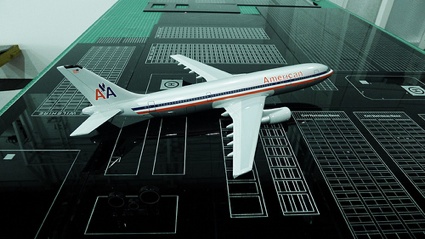
Some legal, political and cultural fields have recently seen a shift from human testimony to material forensics. DNA samples, 3D scans, nano-technology, electro-magnetic microscopes, satellite surveillance and other scientific methods or instruments have started to play a key role in police investigations, political decisions and court room deliberations. Retinal scans, biological remains, landscape topographies and other forensic materials communicate to the judicial system. Just like human witnesses, they come with their own rhetoric of persuasion. Eyal Weizman called it Forensic Aesthetics.
Under Black Carpets is at this stage an early study that will be part of a larger project currently under development. Under Black Carpets presents a meticulous deconstruction of several bank heists simultaneously occurring in downtown Los Angeles, focusing specifically on 5 different banks that centre One Wilshire. The work presents itself as site-specific forensic study. A spatial tool accompanied by a kit of parts, presented as a dense numerical index. Each artifact is individually numbered, assuming the role of the protagonist within the collection and pin-points its own whereabouts on a grid of vertical and horizontal geographical coordinates. The viewer is invited to examine and cross-reference this collection, allowing ones own constructed interpretation of the event as it unfolds from muiltiple, distorted perspectives.
At this point, i needed to pause in my lecture of the description of the project and asked her to tell us more about Under Black Carpets:
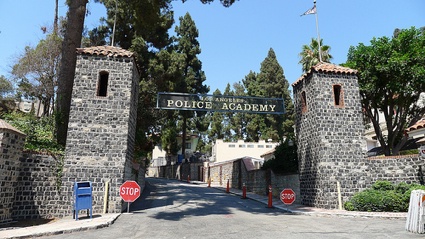
LAPD Police Academy. Image: Ilona Gaynor
Your project is developed in collaboration with the FBI New York Dept of Justice and the LAPD Archival Department. How easy is it to work with them? Who are you working with, i'm not asking for names necessarily, but i'd like to get an idea of the type of person these Department would delegate to work with an artist. Are they scientists working in forensics? Members of their press team?
Firstly, I normally approach my research from a great distance to the subject, but I felt with this particular project, it wasn't going to be quite as effective without actually engaging with the scenarios I wanted to explore.
I wanted to get into the mind-set of what it takes to become a Police officer or 'Cop', so I spent a lot of time at the LAPD Police Academy, watching Police engage in intense training: learning how to drive cars in chase simulations, fire guns and partake in classes reciting American Law and its policies. But furthermore, I spent a lot of time in the Police canteen listening to everyday conversations, which led to me buying a copy of So you want to be a cop: what it takes to serve by Scott Butler and Police bible Pocket Partner by Evers, Miller, Glover and Glover - which is global emergency management manual, carried by United States police officers of all ranks and members of the US government. These books describe in detail precise procedures and policies, coupled with a philosophical mindset of what it takes to serve. I mention this, because it's the dialogue I had within the academy which led to working relationship with the justice department.
I spent sometime with detectives and ex Special Agents in the Bureau's Bank Robbery/Kidnapping/Extortion Dept in New York City, which was actually more of a connection made with my previous work. I attended various meetings and demonstrations with scientists, but not really with biochemists like you would expect in archetypal representations of forensic science, but more with spatial experts and computational homicide scientists. People who examine areas like post-impact ballistics, vessel trajectories and object reassembly.
To put their interest in the project into context If you read any book on heists or homicide published in last 10 years like Where the Money Is: True Tales from the Bank Robbery Capital of the World by Gordon Dillo and William J. Rehder, you will find that every book you come across will have been written by retired FBI agents or an ex-detectives who had worked on the cases cited in the book. The texts are framed (accidentally or not) as a form of nostalgia, not necessarily for documentation or research purposes, but for pleasure. Whilst reading you could even imagine them holding a cup of black filter coffee with a gun lying next to them on their bedside table, they are so personal.
Interestingly enough, they are mostly anecdotal. There are very little facts or figures cited, but more focused on memories and one-liners. As such they are delightful people and splendidly macabre.
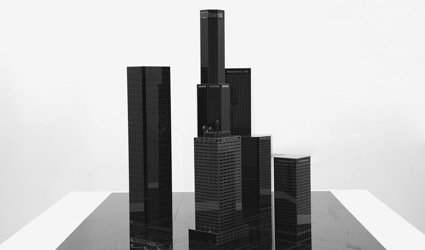
Scale Model of Banks Centering One Wilshire in Downtown Los Angeles
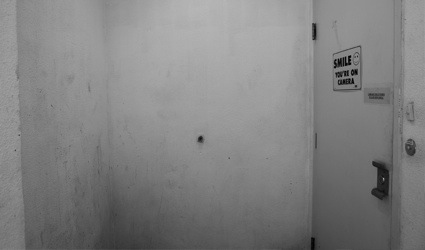
Back Door Entrance, Bank of America
I'm curious about the title of the project: why "Under Black Carpets"? It makes me think of something sinister that has to be hidden...
The title is sinister. It refers to the act and image of stealing. In old cartoons such as Tom and Jerry, Tom the cat would enter the room and slip underneath the carpets, as to sneak upon the mouse (Jerry) in doing this, displaying a huge moving bulge (often cat shaped) that would continually hit furniture and objects in the room because he couldn't see where he was going - alerting Jerry the mouse as to his whereabouts, rendering the espionage futile, but hilarious. Law enforcement bodies are often portrayed in crime cinema as clumsy, often with plans turning sour, foiled by seemingly petty rules and orders given by superiors by act of protocol. The protagonist hero is often a rogue cop who dismisses the rules and catches the criminal. The black carpet; refers to the archetypal colours found in banks, federal buildings and financer's offices. It's also meant to indicate a spatial aspect to the project.
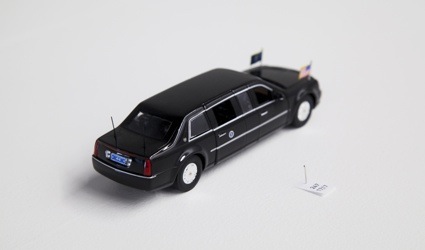
Artifact No.274, Location Coordinates: 17,17, Presidential Limousine
Your project deals with the aesthetic dimension of forensics, a science said to have taken over 'the era of the witness' in legal systems. How much faith do you have in forensics now that you've studied it from up close (well, at least closer than most of us)? Is this science as indefectible as tv series would like us to believe?
Forensic science has blurred a previously held distinction: between evidence, when the law speaks of objects, and that of the witness, referring to subjects, forensics has become something in-between. TV dramas such as CSI in the US and Silent Witness in the UK, really are as accurately based on reality as entertainment would permit- they exist in a world of simulations, computer based conjecture and biologically stained rags in test tubes. Forensics however isn't strictly lab based nor does it always deal with bio-chemistry as I've mentioned previously, that's very much not the case, that plays a significantly small role. And it also very much depends on the nature of the crime and where the crime happened. US crime tends to be more exaggerated and extreme, due to the very nature or culture in which people live, especially in Los Angeles. The crime cases publicized, tend to be lot more spectacular then crimes committed in Britain, of course that's stating the obvious, however I honestly believe that it's related to the cinematic culture, of which we just simply don't have the ability, or want to record and transmit news cinematically. Of course why would we?
Michael Mann's film Heat (1995) was a film shot in downtown LA, with the most notably 'realistic' loud gunplay scene in cinematic history to date. It's cold, blunt and incredibly violent. But what's interesting about that scene is that it became the basis and inspiration for a very real event that happened in LA a few years later, an event dubbed The North Hollywood Shootout I watched repeatedly the news footage from the North Hollywood Shootout and Heat and found that in comparison after repeatedly viewing it intensely, I decided that actually Mann's Heat was far more realistic.
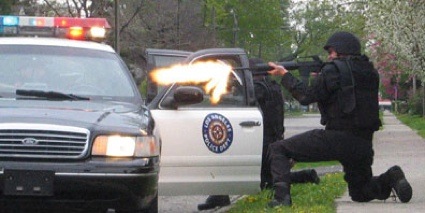
North Hollywood Shoot out. A real robbery that was said to have been a mimicked real life version of the film Heat (as its crime inspiration)
I don't believe anything is infallible, people by nature are cunning and will always find a way to subvert and distort the truth. Even scientific evidence takes form, as rhetoric by the very nature in which is it presented, monopolized or industrialized. I'm not saying that forensic science is inaccurate but it's the way in which we construct or curate the evidence is what makes it key. There have been many miscarriages of justice, with many serious crimes going unsolved. A juridical verdict is a legal argument. The end is not normally the 'truth' of 'what happened', but one of convincing conjecture, which makes it's dimension beautifully fascinating and deadly.
With such a shift on the emphasis of forensics referring back to taking over the 'the era of the witness', I think has left the Police putting too much faith in forensic science, particularly in that of biology, so much so that they have begun to ignore human instinct and intuition, because the definition of truth and reality has never been so unclear.
But then again maybe I'm simply too much of a purist fan of film noir and crime literature.
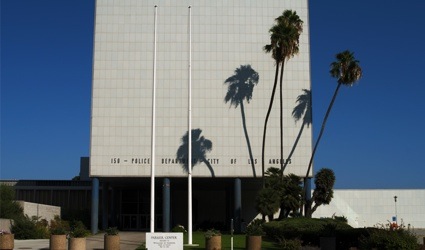
LAPD Police Station, located 6 blocks away from One Wilshire
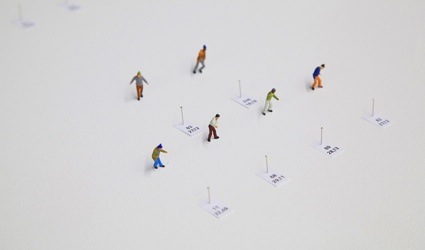
Criminal Activity, Artifact No: 83, 246, 11, 68, 69, 82
Could you also explain the part played by 'forensic aesthetics' in your project?
'Forensic Aesthetics' a term coined by Dr Eyal Weizman at the Department of Visual Cultures at Goldsmiths University. It was an idea that was originally used in an architectural context and was called Forensic Architecture. The idea of using objects to form an argument, as a narration in the absence of actuary evidence is now being openly discussed at various law schools in the US as a mode of future legal practice, which is very exciting! The term is very much at the heart of this project or at least in the research. My project comes into play whereby, I would like to use this theory and expand on the research as a platform to initiate 'it' as a mode of design, by giving it form and materiality. Weizman talks about it the broad context of human rights, of course those are important, but my angle is for pleasure, aesthetic speculation and fantasy. Imagine an architectural model - a designed space accompanied by designed artifacts being wheeled into a courtroom and brought up for questioning almost to fulfill the role of the 'witness' as evidence. Design can become something to examine, question and decipher through legal channels.
The banks are: Bank of America, Mellon Bank, City National Bank, US Bank and Wells Fargo. These were chosen because of their geographic proximity to One Wilshire and precise distance from the LAPD headquarters in downtown LA. The narrative proceeds, a false plane collision with the 30th floor of One Wilshire, as a ruse. One Wilshire is an infamous centralized carrier hotel. It provides half of the worlds connection to the internet; currently it connects: China, Korea, the USA, east Russia and parts of Europe, directing anything toward One Wilshire would attract much attention. The surrounding street block formation would centralize Police, harboring them in one place due to the precise vertical heights of the buildings and the dense geography of those particular blocks. The visual transparency from the ground is also extremely limited. The architecture is positioned in such a way, that staging particular events or moments could be hidden from view behind protruding floors, light refractions from the mirrored glass and thick palm tree heads. Some of the streets are also impossible for helicopters to circulate and enter, however every flat rooftop has its own helipad by state law in that area.
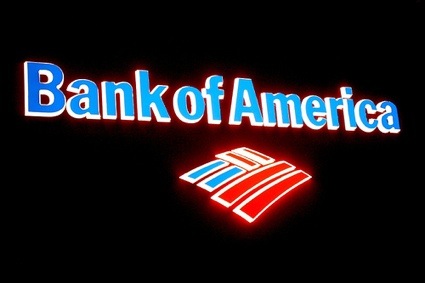
What will be the purpose of the deconstruction? To design the perfect bank robbery?
Yes. Exactly that. My intention is design the perfect heist. A counter measure to anticipated police reactions based on this research. But not presented as projection like a pre-planned, straight-up plot, but one told through hindsight. Using aesthetics and material form to frame the narrative as an investigation, an archive of evidence for the purpose of constructing, a legal argument.
Finally, what shape does the project take: the project page has models but do you also plan to add 3D renderings? video? essays?
This project is simply a study - a deconstruction for the purpose of seeing something from a birds-eye view (not literally) but a plot device to experiment with. This first part was completed whilst I was the summer research resident at Art Center College of Design in Pasadena. The final project will take the form of artifacts, large scale engineered mechanical devices, architectural physical studies, speculative tools and materials. There will be films - my aim is to shoot Police reconstructions of what they assumed to have happened. There's a lot to do!
A book or research will also accompany the project, a series of essays and collated documents curated and co-written by Geoff Manaugh (BLDGBLOG) and myself.
The final work will go into an exhibition on display next year at the Lisbon Architecture Triennale, it will be showing in an unused bank vault comprising of 6 rooms in September 2013.

Scale Model, One Wilshire

Some legal, political and cultural fields have recently seen a shift from human testimony to material forensics. DNA samples, 3D scans, nano-technology, electro-magnetic microscopes, satellite surveillance and other scientific methods or instruments have started to play a key role in police investigations, political decisions and court room deliberations. Retinal scans, biological remains, landscape topographies and other forensic materials communicate to the judicial system. Just like human witnesses, they come with their own rhetoric of persuasion. Eyal Weizman called it Forensic Aesthetics.
Under Black Carpets is at this stage an early study that will be part of a larger project currently under development. Under Black Carpets presents a meticulous deconstruction of several bank heists simultaneously occurring in downtown Los Angeles, focusing specifically on 5 different banks that centre One Wilshire. The work presents itself as site-specific forensic study. A spatial tool accompanied by a kit of parts, presented as a dense numerical index. Each artifact is individually numbered, assuming the role of the protagonist within the collection and pin-points its own whereabouts on a grid of vertical and horizontal geographical coordinates. The viewer is invited to examine and cross-reference this collection, allowing ones own constructed interpretation of the event as it unfolds from muiltiple, distorted perspectives.
At this point, i needed to pause in my lecture of the description of the project and asked her to tell us more about Under Black Carpets:

LAPD Police Academy. Image: Ilona Gaynor
Your project is developed in collaboration with the FBI New York Dept of Justice and the LAPD Archival Department. How easy is it to work with them? Who are you working with, i'm not asking for names necessarily, but i'd like to get an idea of the type of person these Department would delegate to work with an artist. Are they scientists working in forensics? Members of their press team?
Firstly, I normally approach my research from a great distance to the subject, but I felt with this particular project, it wasn't going to be quite as effective without actually engaging with the scenarios I wanted to explore.
I wanted to get into the mind-set of what it takes to become a Police officer or 'Cop', so I spent a lot of time at the LAPD Police Academy, watching Police engage in intense training: learning how to drive cars in chase simulations, fire guns and partake in classes reciting American Law and its policies. But furthermore, I spent a lot of time in the Police canteen listening to everyday conversations, which led to me buying a copy of So you want to be a cop: what it takes to serve by Scott Butler and Police bible Pocket Partner by Evers, Miller, Glover and Glover - which is global emergency management manual, carried by United States police officers of all ranks and members of the US government. These books describe in detail precise procedures and policies, coupled with a philosophical mindset of what it takes to serve. I mention this, because it's the dialogue I had within the academy which led to working relationship with the justice department.
I spent sometime with detectives and ex Special Agents in the Bureau's Bank Robbery/Kidnapping/Extortion Dept in New York City, which was actually more of a connection made with my previous work. I attended various meetings and demonstrations with scientists, but not really with biochemists like you would expect in archetypal representations of forensic science, but more with spatial experts and computational homicide scientists. People who examine areas like post-impact ballistics, vessel trajectories and object reassembly.
To put their interest in the project into context If you read any book on heists or homicide published in last 10 years like Where the Money Is: True Tales from the Bank Robbery Capital of the World by Gordon Dillo and William J. Rehder, you will find that every book you come across will have been written by retired FBI agents or an ex-detectives who had worked on the cases cited in the book. The texts are framed (accidentally or not) as a form of nostalgia, not necessarily for documentation or research purposes, but for pleasure. Whilst reading you could even imagine them holding a cup of black filter coffee with a gun lying next to them on their bedside table, they are so personal.
Interestingly enough, they are mostly anecdotal. There are very little facts or figures cited, but more focused on memories and one-liners. As such they are delightful people and splendidly macabre.

Scale Model of Banks Centering One Wilshire in Downtown Los Angeles

Back Door Entrance, Bank of America
I'm curious about the title of the project: why "Under Black Carpets"? It makes me think of something sinister that has to be hidden...
The title is sinister. It refers to the act and image of stealing. In old cartoons such as Tom and Jerry, Tom the cat would enter the room and slip underneath the carpets, as to sneak upon the mouse (Jerry) in doing this, displaying a huge moving bulge (often cat shaped) that would continually hit furniture and objects in the room because he couldn't see where he was going - alerting Jerry the mouse as to his whereabouts, rendering the espionage futile, but hilarious. Law enforcement bodies are often portrayed in crime cinema as clumsy, often with plans turning sour, foiled by seemingly petty rules and orders given by superiors by act of protocol. The protagonist hero is often a rogue cop who dismisses the rules and catches the criminal. The black carpet; refers to the archetypal colours found in banks, federal buildings and financer's offices. It's also meant to indicate a spatial aspect to the project.

Artifact No.274, Location Coordinates: 17,17, Presidential Limousine
Your project deals with the aesthetic dimension of forensics, a science said to have taken over 'the era of the witness' in legal systems. How much faith do you have in forensics now that you've studied it from up close (well, at least closer than most of us)? Is this science as indefectible as tv series would like us to believe?
Forensic science has blurred a previously held distinction: between evidence, when the law speaks of objects, and that of the witness, referring to subjects, forensics has become something in-between. TV dramas such as CSI in the US and Silent Witness in the UK, really are as accurately based on reality as entertainment would permit- they exist in a world of simulations, computer based conjecture and biologically stained rags in test tubes. Forensics however isn't strictly lab based nor does it always deal with bio-chemistry as I've mentioned previously, that's very much not the case, that plays a significantly small role. And it also very much depends on the nature of the crime and where the crime happened. US crime tends to be more exaggerated and extreme, due to the very nature or culture in which people live, especially in Los Angeles. The crime cases publicized, tend to be lot more spectacular then crimes committed in Britain, of course that's stating the obvious, however I honestly believe that it's related to the cinematic culture, of which we just simply don't have the ability, or want to record and transmit news cinematically. Of course why would we?
Michael Mann's film Heat (1995) was a film shot in downtown LA, with the most notably 'realistic' loud gunplay scene in cinematic history to date. It's cold, blunt and incredibly violent. But what's interesting about that scene is that it became the basis and inspiration for a very real event that happened in LA a few years later, an event dubbed The North Hollywood Shootout I watched repeatedly the news footage from the North Hollywood Shootout and Heat and found that in comparison after repeatedly viewing it intensely, I decided that actually Mann's Heat was far more realistic.

North Hollywood Shoot out. A real robbery that was said to have been a mimicked real life version of the film Heat (as its crime inspiration)
I don't believe anything is infallible, people by nature are cunning and will always find a way to subvert and distort the truth. Even scientific evidence takes form, as rhetoric by the very nature in which is it presented, monopolized or industrialized. I'm not saying that forensic science is inaccurate but it's the way in which we construct or curate the evidence is what makes it key. There have been many miscarriages of justice, with many serious crimes going unsolved. A juridical verdict is a legal argument. The end is not normally the 'truth' of 'what happened', but one of convincing conjecture, which makes it's dimension beautifully fascinating and deadly.
With such a shift on the emphasis of forensics referring back to taking over the 'the era of the witness', I think has left the Police putting too much faith in forensic science, particularly in that of biology, so much so that they have begun to ignore human instinct and intuition, because the definition of truth and reality has never been so unclear.
But then again maybe I'm simply too much of a purist fan of film noir and crime literature.

LAPD Police Station, located 6 blocks away from One Wilshire

Criminal Activity, Artifact No: 83, 246, 11, 68, 69, 82
Could you also explain the part played by 'forensic aesthetics' in your project?
'Forensic Aesthetics' a term coined by Dr Eyal Weizman at the Department of Visual Cultures at Goldsmiths University. It was an idea that was originally used in an architectural context and was called Forensic Architecture. The idea of using objects to form an argument, as a narration in the absence of actuary evidence is now being openly discussed at various law schools in the US as a mode of future legal practice, which is very exciting! The term is very much at the heart of this project or at least in the research. My project comes into play whereby, I would like to use this theory and expand on the research as a platform to initiate 'it' as a mode of design, by giving it form and materiality. Weizman talks about it the broad context of human rights, of course those are important, but my angle is for pleasure, aesthetic speculation and fantasy. Imagine an architectural model - a designed space accompanied by designed artifacts being wheeled into a courtroom and brought up for questioning almost to fulfill the role of the 'witness' as evidence. Design can become something to examine, question and decipher through legal channels.
It's very interesting to me to relentlessly construct narratives from traces that were left over from a traumatic or chaotic event, even if you are stitching together empty spaces that seem impossible and too abstract. The documentation of everyday detail in the construction of archives of clues and cases creates a great pool for crafting hybrid fictions and competing perceptions - a world of secret lives, lies and stories.
Under Black Carpets presents a meticulous deconstruction of several bank heists simultaneously occurring in downtown Los Angeles, focusing specifically on 5 different banks that centre One Wilshire. What are these banks?The banks are: Bank of America, Mellon Bank, City National Bank, US Bank and Wells Fargo. These were chosen because of their geographic proximity to One Wilshire and precise distance from the LAPD headquarters in downtown LA. The narrative proceeds, a false plane collision with the 30th floor of One Wilshire, as a ruse. One Wilshire is an infamous centralized carrier hotel. It provides half of the worlds connection to the internet; currently it connects: China, Korea, the USA, east Russia and parts of Europe, directing anything toward One Wilshire would attract much attention. The surrounding street block formation would centralize Police, harboring them in one place due to the precise vertical heights of the buildings and the dense geography of those particular blocks. The visual transparency from the ground is also extremely limited. The architecture is positioned in such a way, that staging particular events or moments could be hidden from view behind protruding floors, light refractions from the mirrored glass and thick palm tree heads. Some of the streets are also impossible for helicopters to circulate and enter, however every flat rooftop has its own helipad by state law in that area.

What will be the purpose of the deconstruction? To design the perfect bank robbery?
Yes. Exactly that. My intention is design the perfect heist. A counter measure to anticipated police reactions based on this research. But not presented as projection like a pre-planned, straight-up plot, but one told through hindsight. Using aesthetics and material form to frame the narrative as an investigation, an archive of evidence for the purpose of constructing, a legal argument.
Finally, what shape does the project take: the project page has models but do you also plan to add 3D renderings? video? essays?
This project is simply a study - a deconstruction for the purpose of seeing something from a birds-eye view (not literally) but a plot device to experiment with. This first part was completed whilst I was the summer research resident at Art Center College of Design in Pasadena. The final project will take the form of artifacts, large scale engineered mechanical devices, architectural physical studies, speculative tools and materials. There will be films - my aim is to shoot Police reconstructions of what they assumed to have happened. There's a lot to do!
A book or research will also accompany the project, a series of essays and collated documents curated and co-written by Geoff Manaugh (BLDGBLOG) and myself.
The final work will go into an exhibition on display next year at the Lisbon Architecture Triennale, it will be showing in an unused bank vault comprising of 6 rooms in September 2013.
Design Fiction: Ilona Gaynor’s perfect bank heist
By Bruce Sterling
*Since this effort is sheltered by a design school, it’s design in origin, but one feels it needs some more accurate generic term than “design fiction.” I don’t doubt that imaginary bank heists are very interesting (and hopefully fictional), but it seems odd to rank a creative effort of this kind with, say, Corning videos about how nice it would be to walk around stroking glass panes all day. It doesn’t seem to play to the same audience or convey the same affect.*”Forensic aesthetics” is quite an interesting concept. Maybe this work should be ranked with the likes of historical re-enactment experiences — dressing up with meticulous Civil War detail to re-play Pickett’s Charge.
http://we-make-money-not-art.com/archives/art_in_california/
(…)
What will be the purpose of the deconstruction? To design the perfect bank robbery?
Yes. Exactly that. My intention is design the perfect heist. A counter measure to anticipated police reactions based on this research. But not presented as projection like a pre-planned, straight-up plot, but one told through hindsight. Using aesthetics and material form to frame the narrative as an investigation, an archive of evidence for the purpose of constructing, a legal argument.
Finally, what shape does the project take: the project page has models but do you also plan to add 3D renderings? video? essays?
This project is simply a study – a deconstruction for the purpose of seeing something from a birds-eye view (not literally) but a plot device to experiment with. This first part was completed whilst I was the summer research resident at Art Center College of Design in Pasadena. The final project will take the form of artifacts, large scale engineered mechanical devices, architectural physical studies, speculative tools and materials. There will be films – my aim is to shoot Police reconstructions of what they assumed to have happened. There’s a lot to do!
A book or research will also accompany the project, a series of essays and collated documents curated and co-written by Geoff Manaugh (BLDGBLOG) and myself.
The final work will go into an exhibition on display next year at the Lisbon Architecture Triennale, it will be showing in an unused bank vault comprising of 6 rooms in September 2013.
http://we-make-money-not-art.com/archives/art_in_california/
(…)
What will be the purpose of the deconstruction? To design the perfect bank robbery?
Yes. Exactly that. My intention is design the perfect heist. A counter measure to anticipated police reactions based on this research. But not presented as projection like a pre-planned, straight-up plot, but one told through hindsight. Using aesthetics and material form to frame the narrative as an investigation, an archive of evidence for the purpose of constructing, a legal argument.
Finally, what shape does the project take: the project page has models but do you also plan to add 3D renderings? video? essays?
This project is simply a study – a deconstruction for the purpose of seeing something from a birds-eye view (not literally) but a plot device to experiment with. This first part was completed whilst I was the summer research resident at Art Center College of Design in Pasadena. The final project will take the form of artifacts, large scale engineered mechanical devices, architectural physical studies, speculative tools and materials. There will be films – my aim is to shoot Police reconstructions of what they assumed to have happened. There’s a lot to do!
A book or research will also accompany the project, a series of essays and collated documents curated and co-written by Geoff Manaugh (BLDGBLOG) and myself.
The final work will go into an exhibition on display next year at the Lisbon Architecture Triennale, it will be showing in an unused bank vault comprising of 6 rooms in September 2013.
Posted by Ray | 5 Jun 2013

You couldn't make it up—or could you? The fact that a London-based artist/designer is turning to a popular crowdfunding platform to launch her latest project is hardly newsworthy, but it turns out that Ilona Gaynor is looking to plan an extremely elaborate bank robbery (a somewhat ironic twist on a certain topical New Yorker cartoon).

Gaynor has been plotting "Under Black Carpets" for some two years now, waiting for the perfect opportunity to strike her hitlist of five major banks at One Wilshire in downtown Los Angeles. What originated as an architectural observation—she notes that "particular events or moments could be hidden from view behind protruding floors, light refractions from the mirrored glass and thick palm tree heads"—has now evolved into an obsession: to get away with the perfect heist.

To that end, she's consulted the FBI, the LAPD, forensics experts and criminal attorneys, as well as potential accomplices such as private investigators, security experts and escape artists. Each has been instrumental in providing the seeds of truth that Gaynor has cultivated into a plot that is "overly fragmented, confusing and complex, much like that of a police investigation. The answer is still cloudy and unclear, but with hope for resolution."

Of course, her endeavor is somehow all the more ambitious since she won't actually be robbing any banks: "Under Black Carpets" is an immersive work of fiction, to be exhibited at the Lisbon Architecture Triennale at the end of this year. The speculative heist will be exhibited as a fabricated police investigation, such that the narrative is presented in hindsight, comprised of "the remaining evidential material after the event has taken place, something that could be argued or challenged as material (evidence) in a court of law. The work itself will take form as sculptures, architectural models, technical drawings, films and photography."
The work presents itself as site-specific forensic study. A spatial tool accompanied by a kit of parts, presented as a dense numerical index. Each artifact is individually numbered, assuming the role of the protagonist within the collection and pin-points it's own whereabouts on a grid of vertical and horizontal geographical coordinates. The viewer is invited to examine and cross-reference this collection, allowing ones own constructed interpretation of the event as it unfolds from muiltiple, distorted perspectives.

Gaynor, who completed her MA in Design Interactions at RCA in 2011, has made it quite clear that she doesn't actually intend to rob any banks on the Kickstarter page and elsewhere, but I almost wish she could get away with proposing the project in earnest, sans disclaimers and caveats.
Indeed, "Under Black Carpets" seems to have more in common with film than any other artistic discipline, and Gaynor tellingly cites the shootout from Heat as an instance of fiction becoming reality (if you're particularly interested in the concepts at play, the entire September 2012 interview is well worth reading).

Conversely, it so happens that another, rather less profound work of design fiction also turned up in the inbox last week. "A Chair Named Clarity" is essentially everything that "Under Black Carpets" is not:
Although the premise of the short and the 'training' montage are charming, it's something like a children's book rendition of 'design fiction'—literally, a story about an anthropomorphized design object, Allsteel's "Clarity" Chair. It lies on the opposite end of the spectrum as a work of art... which is to say that it's essentially a commercial dressed up as nicely-produced albeit thinly-veiled allegory (I imagine the budget was comparable to Gaynor's £20,000 Kickstarter goal). It's pleasantly diverting, perhaps, in its artlessness, but the stark contrast between the two works simply underscores the fact that the power of suggestion, or withholding the truth, goes a long way towards narrative structure. (Gaynor elaborates on Eyal Weizman's notion of "forensic aesthetics" in the interview.)

Gaynor, for her part, told Wired that "I kind of ignore traditional, industrial product design because I'm just not interested."
 Rewards for "Under Black Carpets" backers include A2 posters and the research book
Rewards for "Under Black Carpets" backers include A2 posters and the research bookThe campaign will be live for another two weeks (as of press time, Gaynor was well short of her funding goal); learn more on "Under Black Carpets" Kickstarter page.
kickstarting a bank heist: under black carpets by ilona gaynorall images © ilona gaynor
in a response to the subversive narrative of bank heists, 'under black carpets' by london-based designer ilona gaynor presents an investigation into the use and misuse of the cityscape, where architecture is considered both the obstacle and the tool for disparate agendas. understanding the built form as an entity rather than a witness, the designer uses the parameters of the legal system and investigative methodologies and put these limits in dialogue with the elements of architecture; namely circulation, mass and movement. working in collaboration with the FBI, new york department of justice and the LAPD archives, an iteration of the project is being presented at the lisbon architecture triennale with the hope that further funding for more design probing will be possible. 'under black carpets' questions the algorithmic ability of architecture to posit a meticulous deconstruction of several bank heists, using a real life case study of simultaneously occurring thefts in downtown los angeles, focusing specifically on five different banks that centre the famous 'one wilshire' theft.
the designer on the project:
today's legal and political decisions are often based upon the capacity to display and read DNA samples, 3D laser scans, nano-tech, and the enhanced vision of electromagnetic microscopes and satellite surveillance. from retinal scans, biological remains, landscape topographies, to the remnants of destroyed buildings, forensics is not only about diagnostics, but also about the rhetoric of persuasion. the aesthetic dimension includes it's means of presentation, the theatrics of its delivery, and it's form of image and gesture.
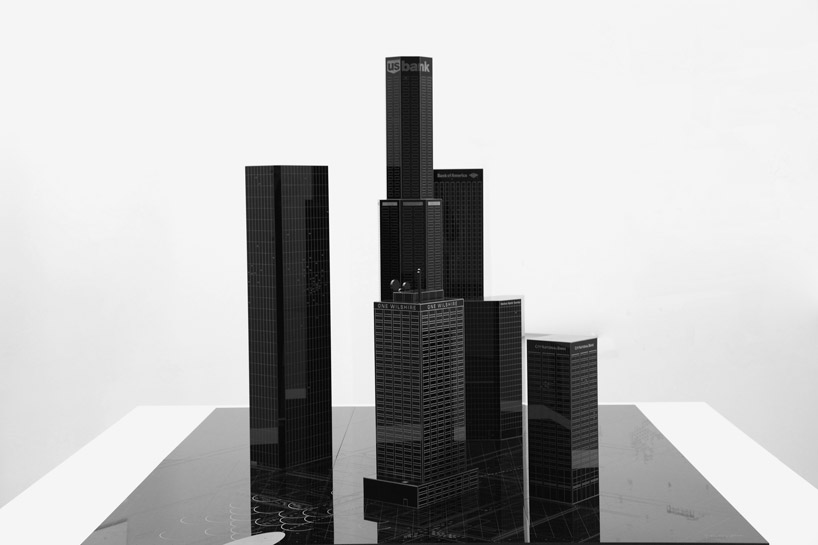
scale model of downtown los angeles
the work is presented as site-specific forensic study utilizing a spatial-visual objects accompanied by a kit of parts. each scale figure and
model is presented as a catalog of protagonists; while each artifact is individually numbered to provide a clear reconstruction of the heists.
durational events are pin-pointed and etched on a grid of vertical and horizontal geographical coordinates. the viewer is invited to examine and
ross-reference this collection, allowing a subjective interpretation of the events unfold from multiple, albeit constructed perspectives. models and
designed objects frame a flawed narrative that purposely lacks in linearity as it conflates and collapses time. the shortcomings of the architectural
landscape are purposefully curated with the intention of present the confusing, fragmented course of a police investigation and possibilities of the
fragmented physical/non-physical vestiges. the project does not propose a solution, but rather highlights the shortcomings of built space and the
immense difficulty of rebuilding time as it is complicated by history.
archaeologist michael shanks expands on stories and fragmentation:
'stories are told… stories are extracted. stories are constructed in those operations which impose order and reason, of hygiene, empowerment and
disempowerment - some believed, some discarded. there are miscarriages of justice, and can we ever know the mind of the criminal? entropic fragments,
traces, terminal associations, aftermath, degradation, the sedimentation of everyday life, haunting absences -
this is also, we propose, an archaeological sensibility.'
'under black carpets' kickstarter video
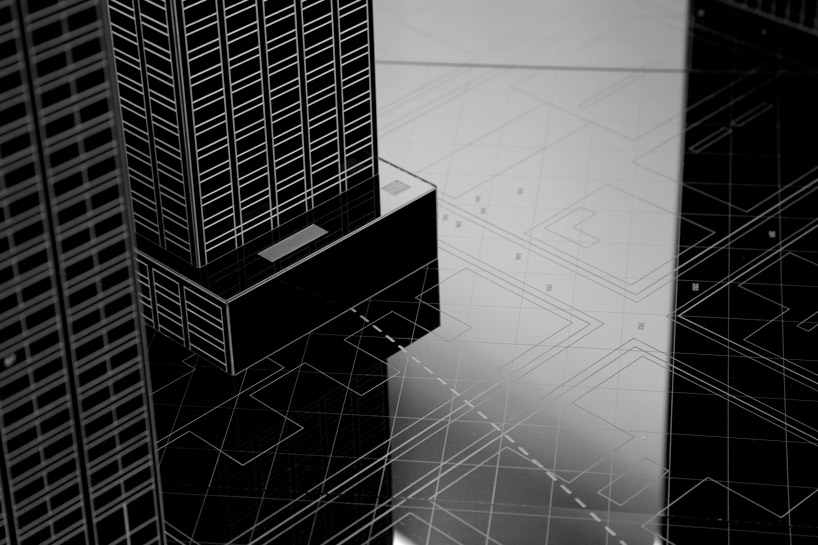
grid and indexed map of events
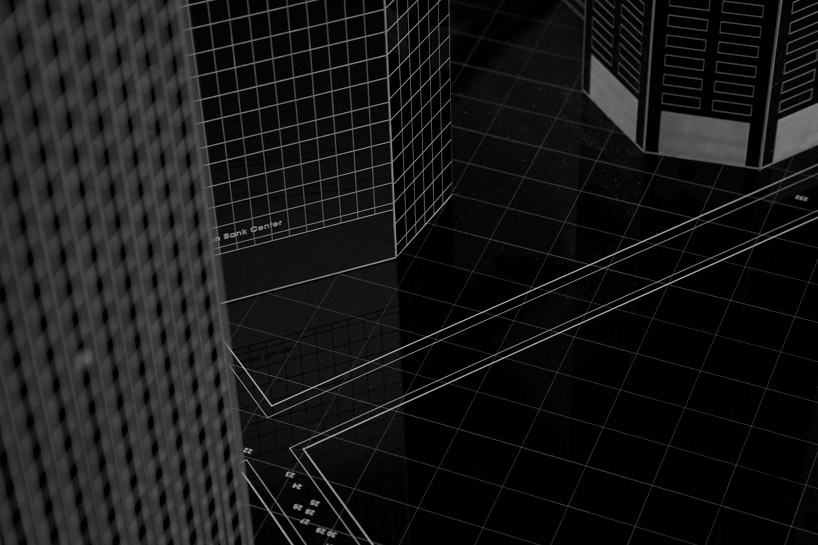
scale model detail
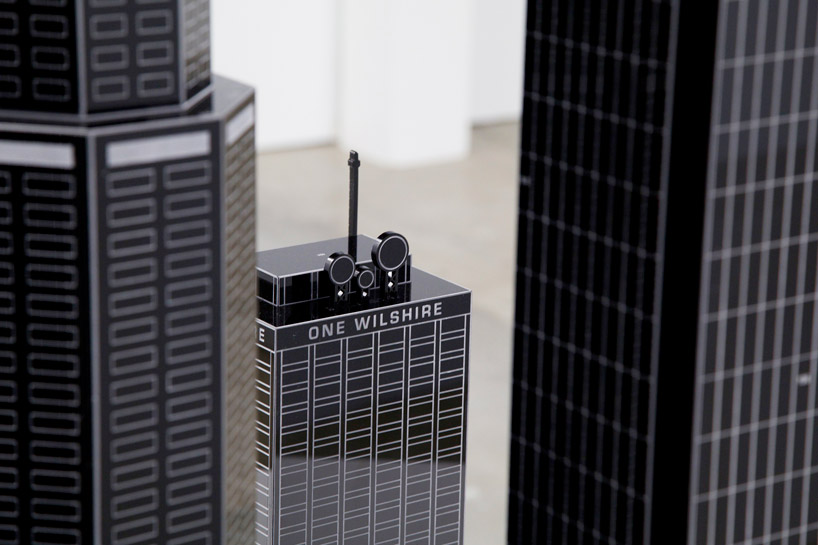
'one wilshire' and the surrounding five targeted banks
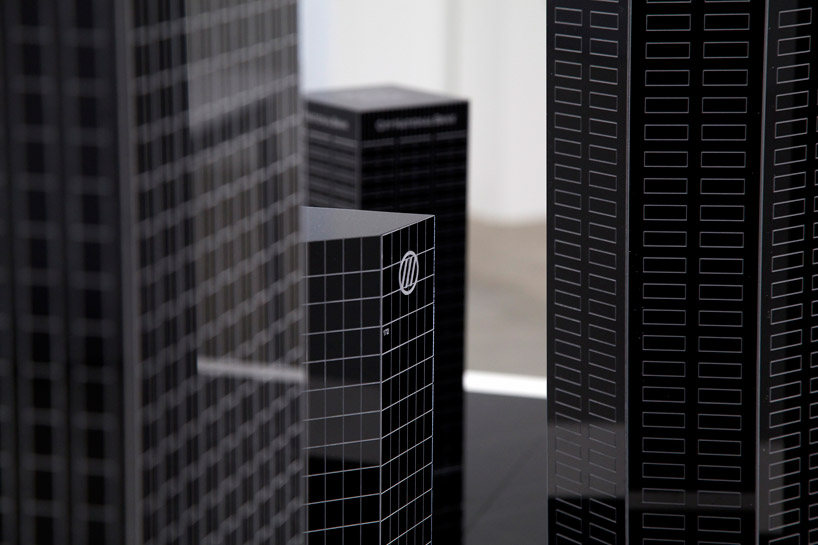
detail of the five other banks
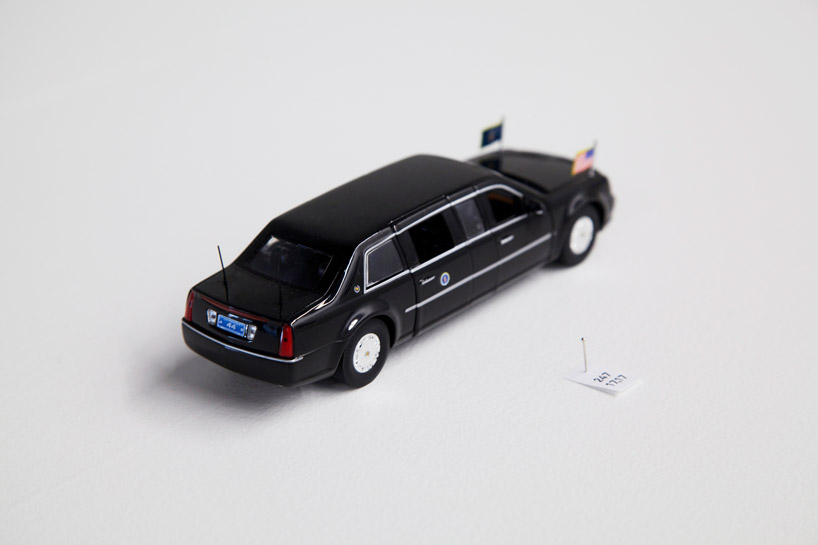
presidential limousine: a presidential visit to the city creates a baracade, focusing news crew's TV cameras on the vehicle and the president
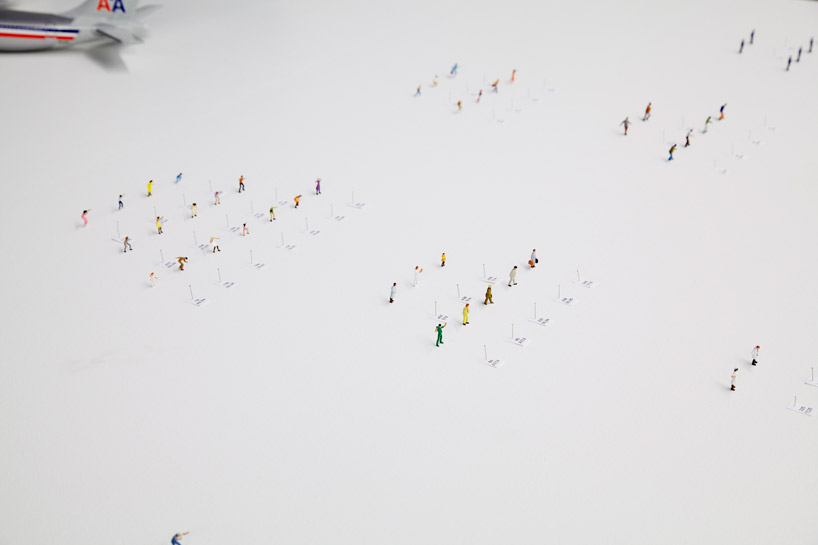
the players: bystanders, witnesses, police, heros, jumpers, women and children, hostages
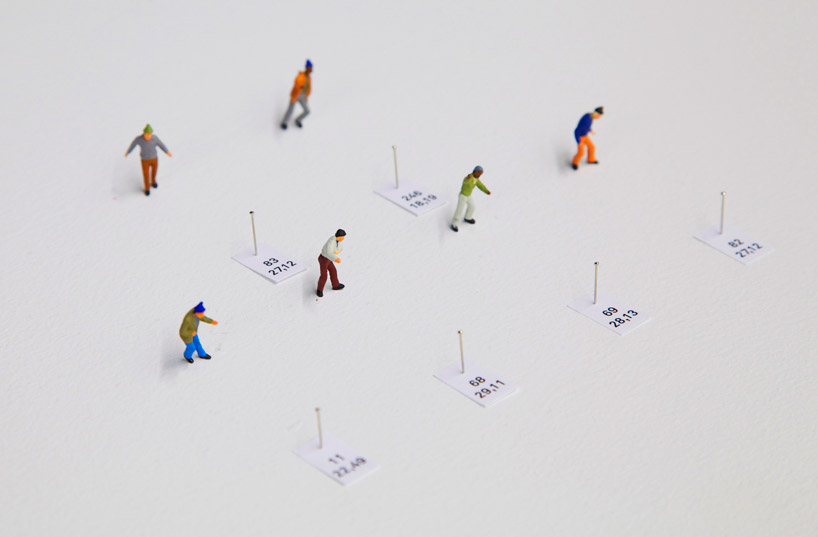
model details
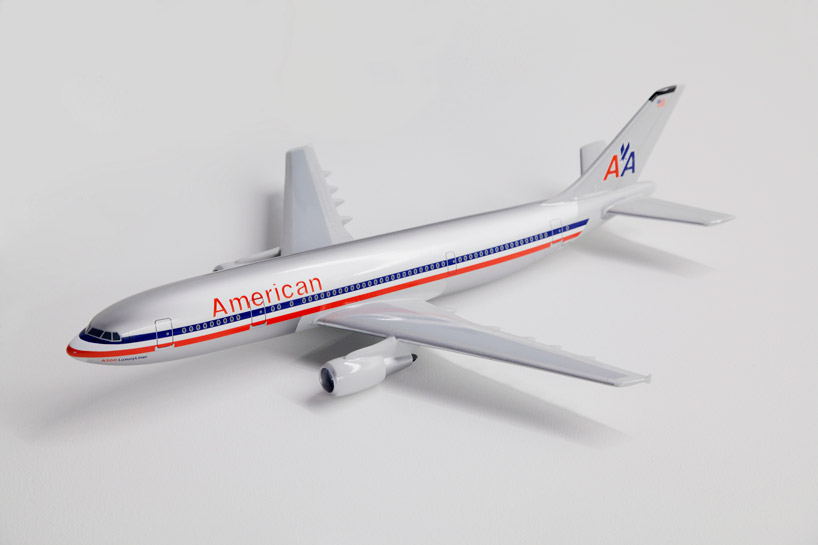
the vessels: american airlines A300 drops its payload over one wilshire

appropriated US air force jet to a location over in west hollywood

model detail
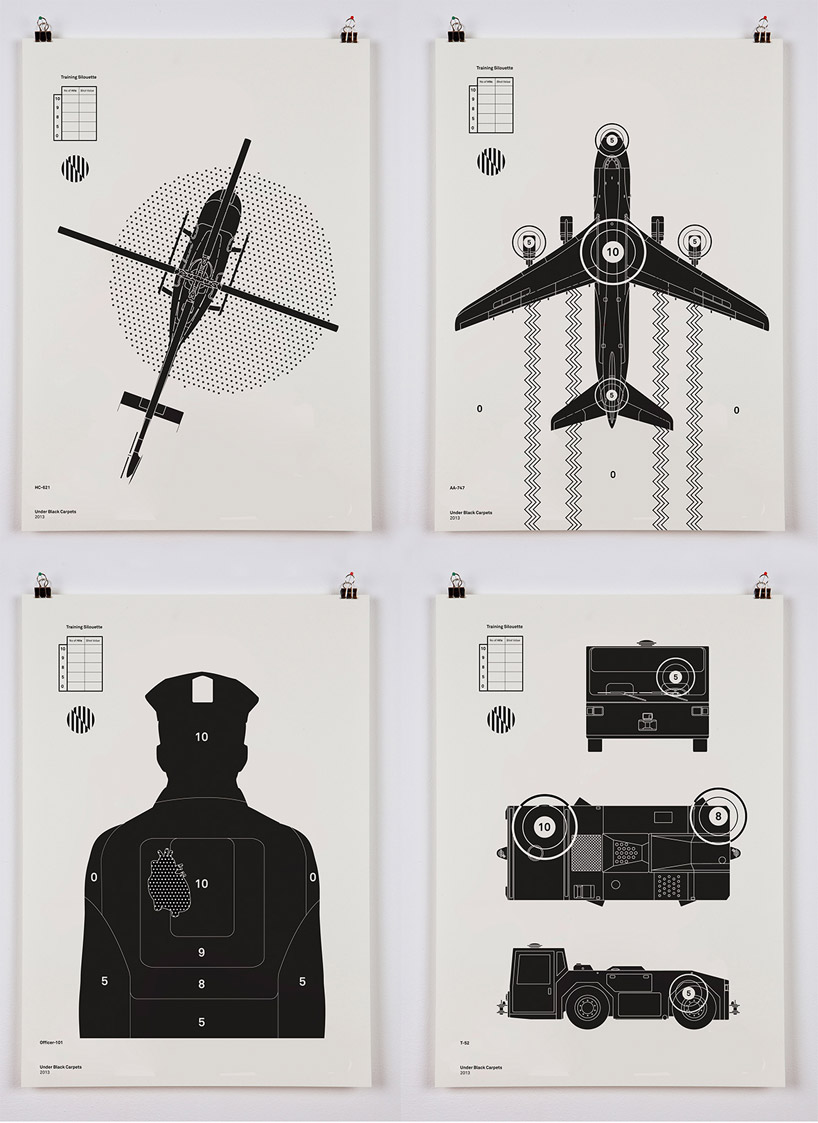
four shooting silouettes, A2 posters
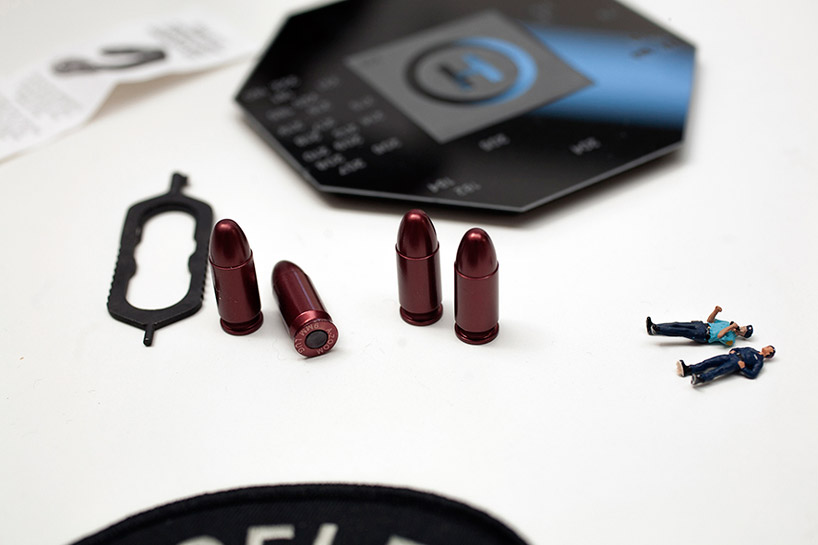
kickstarter reward memorabilia
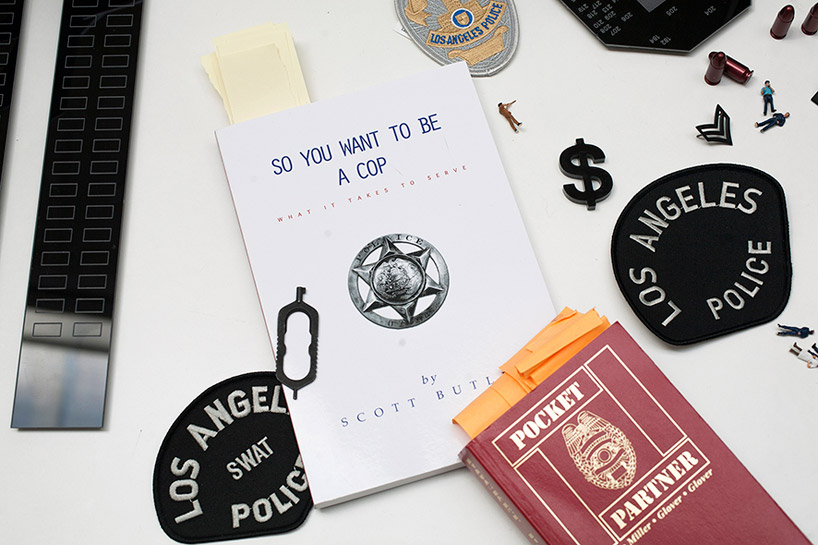
kickstarter reward memorabilia
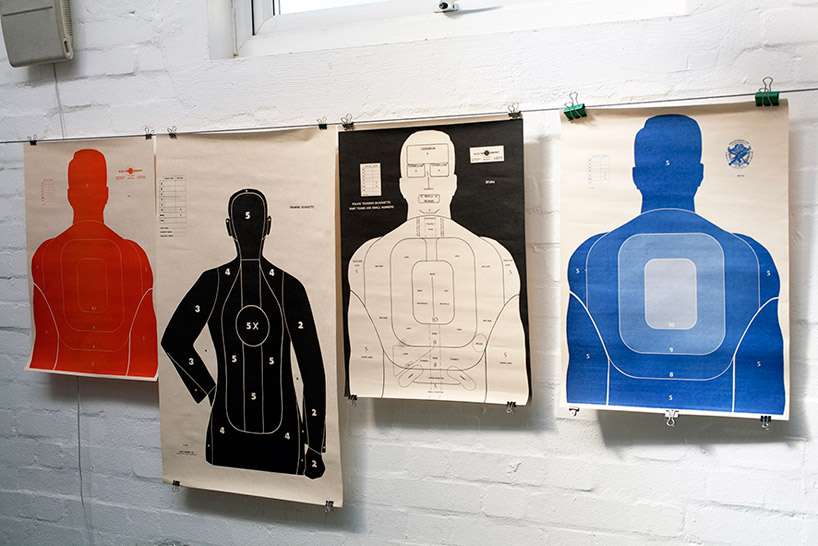
shooting targets + research
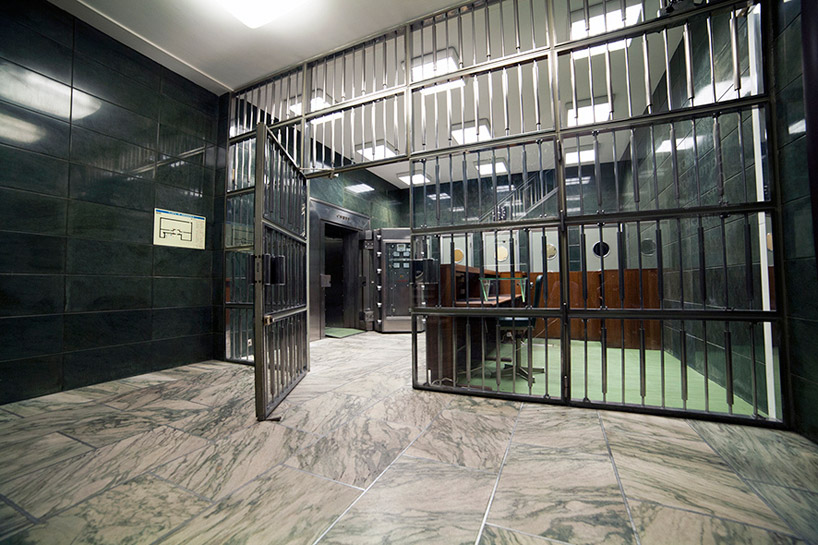
an inside look at the bank vaults

an inside look at the bank vaults
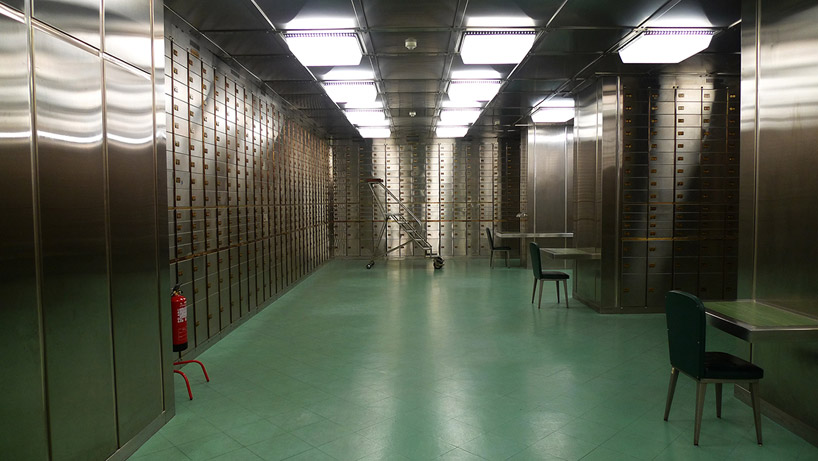
an inside look at the bank vaults
- www.designboom.com/

Predictable Anomalies
(this project is currently ongoing)
When JFK was assassinated in 1963, the US government’s department of justice, over a 10 year period, set out to investigate precisely how one singular individual could outsmart, outshine and outwit the FBI in killing the most popular president in history of the United States.
This project is a photographic essay exploring the intersection between living economies, physics and fiction. The aim of the project was to use actuary scientific analysis, mathematic theorems and petty
bureaucracy as a designed plot to assassinate the US president with the intent to make the murder appear as if it was an accident.
The blessed event was to occur on Independence Day, the weapon being the US flag situated on the roof of the White House in Washington DC. Working with Physicists and Mathematicians at Imperial College in London, we calculated varying wind speeds, annual probabilities of rain fall, and structural engineered biased strengths and weaknesses related to the flag and the architectural structure of the Whitehouse. I also consulted with a director an investments director at the since liquidated Lehman Brothers in London to examine which insurance practices could impose various geographical limitations on the presidents whereabouts, forcing him into position.
The project was presented as 60 narrated photographs detailing the plot and probable variants and a scale model of the Whitehouse, the flag and the president.
(this project is currently ongoing)
When JFK was assassinated in 1963, the US government’s department of justice, over a 10 year period, set out to investigate precisely how one singular individual could outsmart, outshine and outwit the FBI in killing the most popular president in history of the United States.
This project is a photographic essay exploring the intersection between living economies, physics and fiction. The aim of the project was to use actuary scientific analysis, mathematic theorems and petty
bureaucracy as a designed plot to assassinate the US president with the intent to make the murder appear as if it was an accident.
The blessed event was to occur on Independence Day, the weapon being the US flag situated on the roof of the White House in Washington DC. Working with Physicists and Mathematicians at Imperial College in London, we calculated varying wind speeds, annual probabilities of rain fall, and structural engineered biased strengths and weaknesses related to the flag and the architectural structure of the Whitehouse. I also consulted with a director an investments director at the since liquidated Lehman Brothers in London to examine which insurance practices could impose various geographical limitations on the presidents whereabouts, forcing him into position.
The project was presented as 60 narrated photographs detailing the plot and probable variants and a scale model of the Whitehouse, the flag and the president.
Film: vimeo.com/12032656

Orientation Film
Orientation Film, is a fictional artifact designed
for the corporate world of tomorrow. The pathological pursuit for profit has never been higher.
The dream is here. Ubiquitous computing has finally been
realised. But is it the dream we imagined?
Imagine a world where companies adopt and monitor their
profit margins by individually measuring and managing
employee efficiency levels, through a complex system of
networked sensory objects and devices, analysed by machines
working autonomously. A radical infrastructure, where hiring,
promotions and firing is more of a rational, economical process
based on several carefully monitored and aligned sets of data.
Measured units of oxygen (measuring the ability to cope with
stress by detecting heavy breathing), heart pulse (predicting
potential health problems, such as heart attacks leading to
significant time off), individual, material surplus consumption
(measuring micro spending levels, such as post-it notes and
staples) and noise levels (listening for abnormally high noise
levels, to detect suspected fowl play)
Profits soar, the economy is healthy and risk is at an all time
low. But does this outweigh the human cost? How might we
cope in this technologically driven environment? How might
formulated policy change?Would we embrace it, exploit it,
even learn to like it?
Orientation Film, is a fictional artifact designed
for the corporate world of tomorrow. The pathological pursuit for profit has never been higher.
The dream is here. Ubiquitous computing has finally been
realised. But is it the dream we imagined?
Imagine a world where companies adopt and monitor their
profit margins by individually measuring and managing
employee efficiency levels, through a complex system of
networked sensory objects and devices, analysed by machines
working autonomously. A radical infrastructure, where hiring,
promotions and firing is more of a rational, economical process
based on several carefully monitored and aligned sets of data.
Measured units of oxygen (measuring the ability to cope with
stress by detecting heavy breathing), heart pulse (predicting
potential health problems, such as heart attacks leading to
significant time off), individual, material surplus consumption
(measuring micro spending levels, such as post-it notes and
staples) and noise levels (listening for abnormally high noise
levels, to detect suspected fowl play)
Profits soar, the economy is healthy and risk is at an all time
low. But does this outweigh the human cost? How might we
cope in this technologically driven environment? How might
formulated policy change?Would we embrace it, exploit it,
even learn to like it?
Film: vimeo.com/11660830

Synecdoche, Hills
Financial crime is becoming extensively more abstract.
Today we see breaches of privacy and theft using highly
auspicious varieties of Malware: from phishing scams, data
skimming to DNA hacking and insider trading, which due to
obvious progress will only get increasingly more innovative,
upon breaching the horizon. However, I don't think the
underlying framework of inherent theft will ever change, but
perhaps we will be exposed to more sophisticated varieties
or versions, even 'worlds' of what's past.
Today we see breaches of privacy and theft using highly
auspicious varieties of Malware: from phishing scams, data
skimming to DNA hacking and insider trading, which due to
obvious progress will only get increasingly more innovative,
upon breaching the horizon. However, I don't think the
underlying framework of inherent theft will ever change, but
perhaps we will be exposed to more sophisticated varieties
or versions, even 'worlds' of what's past.
I'd like to believe that the future deserves a criminal that
operates and values crime (an act) as a seminal, more poetic
and long-term undertaking, something that nods towards
tradition and ceremony and even a new infrastructure.
operates and values crime (an act) as a seminal, more poetic
and long-term undertaking, something that nods towards
tradition and ceremony and even a new infrastructure.
My proposal for a future crime is to design a speculative virtual
city (within Second Life) exclusively built for shopping and
entertainment purposes, much like Abu Dhabi, Las Vegas,
Disney Land or Beverly Hills - consisting of virtually constructed
shopping malls, restaurants and theme parks. The city will be
solely managed by fraudulent (fake) accounted avatars. Whom
are operated by a large co-conspiratorial network of people,
employed to sell and serve in everyday establishments, like pizza
restaurants,gift shops and casinos. The city will act as a ruse,
a meta playground where real money can be perpetually
laundered and exchanged across the globe to front (real) stolen
property, ransom demands, gambling betting, payoffs
and extortion.
city (within Second Life) exclusively built for shopping and
entertainment purposes, much like Abu Dhabi, Las Vegas,
Disney Land or Beverly Hills - consisting of virtually constructed
shopping malls, restaurants and theme parks. The city will be
solely managed by fraudulent (fake) accounted avatars. Whom
are operated by a large co-conspiratorial network of people,
employed to sell and serve in everyday establishments, like pizza
restaurants,gift shops and casinos. The city will act as a ruse,
a meta playground where real money can be perpetually
laundered and exchanged across the globe to front (real) stolen
property, ransom demands, gambling betting, payoffs
and extortion.
Film: vimeo.com/65515000
Rooms (Ongoing Series)
Architectural environments, the design and construction
of which are driven specifiaclly by the terms, conditions
and clauses found within specific insurance documentation,
that intern examine the aesthetics of risk mititgation.
1. Kidnap and Ransom
2. Severence, Building and Contents
Architectural environments, the design and construction
of which are driven specifiaclly by the terms, conditions
and clauses found within specific insurance documentation,
that intern examine the aesthetics of risk mititgation.
1. Kidnap and Ransom
2. Severence, Building and Contents
Films: www.ilonagaynor.co.uk/Rooms/

Do You Like Our Owl?
It's Artificial? Of Course it is.
Written by (Ilona Gaynor)
An essay exploring a conceptual framework for designers interested in constructing fictional worlds as a method for communicating speculative societal systems, brands and imagined tangents.
This essay was a dissertation submitted to Critical Historical Studies at the Royal College of Art, in October 2010 and received a grade of distinction.
It's Artificial? Of Course it is.
Written by (Ilona Gaynor)
An essay exploring a conceptual framework for designers interested in constructing fictional worlds as a method for communicating speculative societal systems, brands and imagined tangents.
This essay was a dissertation submitted to Critical Historical Studies at the Royal College of Art, in October 2010 and received a grade of distinction.




Excerpt
Chapter 2, Gateways, beyond the beyond.
'If design can be a way of creating material objects that help tell a story what kind of stories would it tell and in what style or genre?'1 A designed artefact can connect an idea to its expression as a made, crafted, instantiated object. These material objects that have a form, texture a certain level of intensity that becomes real before them-selves. They sit on a landscape of meaning that pre-exits them, because 'they could never exist outside of an imagined use of context, however mundane or vernacular that imagined context of social practices might be. Objects tell stories, even by themselves. In cinema they act as props or in design they act as conversation pieces that help speculate, reflect and imagine a world without the use for words.'2 They are items around which a narrative is weaved, and this helps us to imagine and plot out the details of the environment in which they are located. But they can also act as 'gateways' into other kinds of worlds: extrapolated tangents, parallels and instances that exist beyond the immediate experience of the narrative, giving us a dense picture about where the ideas and themes originated and of course where they cross over at points of familiarity with our own world. Of course hyper detailed and referential mise-en-scene is an investment and could be argued that it is partly a result of a release 'new' technologies such as DVD and Blue Ray. Digital special effects make it relatively 'simple' to produce microscopic, intensively overlaid, hybrid and hyper real environments. It could be said that there is a certain level of assumption made by the viewer to expect a high standard of detail that will result in repeated and sometimes highly selective viewings, which will scrutinize and enjoy detail that would normally be missed in a theatrical viewing. There are four main strands where these existential gateways come into reflection.
Product placement 'Product placement is a form of advertising, where branded goods or services are placed in a context usually devoid of ads, such as movies, the story line of television shows, or news programs. The product placement is often not disclosed at the time that the good or service is featured.'3 Product placement still exists and is a 'successful' tool for communicating brands within a consumer-generated framework. Most film critics would state that product placement is 'absurd' and 'putrefies the environment'4 David Lynch goes as far to say when asked his opinion about the subject 'Bullshit. That's how I feel, total fucking bullshit... what kind of world is this?'5 It is fair to say that the bottom line intention from advertising is to make money and if spending big budgets on film funding in order to get a product in front of the eyes of attentive viewers, so be it. However it could be argued that products (in some instances) allow us to tell more compelling 'believable' stories by reflecting the world and western culture we live in, through including its most dominant brands. It allows us to enter the cinematic world presented before us and find comfort in being surrounded by familiar artefacts and brands that work their way into our daily lives. However by 'anchoring' a brand into a film, we become more familiar with the world pervasive branding, which arguably therefore works to constrain what can be done in regards to the production and freedom of the film. HBO's Sex and the City is publicized for use of its product placement, referred to as 'the "Film Whore" who "sold out" for marketing'6 and is often shunned for doing so, brands included: Mercedes-Benz, Coty fragrances and Sky vodka, as well as the jeweller Stern; Glaceau Vitamin Water, Coca-Cola, Starbucks (see Illus) and Bag Borrow and Steal. However it could be argued that Sex and the City is 'built on a foundation of material goods'7 after all here exists a world, which is described as 'socialite Manhattan' where glamorous women live to work, socialize and spend. Where else would Carrie Bradshaw (Sarah Jessica Parker) be drinking her $5 cup of coffee?
In Robert Zemekis's Forrest Gump (1994) Forrest (Tom Hanks) takes a large sum of his hard earned fortune and invests it in what he refers to as some 'sorta fruit company'8 this is ironic, in the sense that the company he invests in is Apple Computers Inc (see illus) At the time of films release in 1994, Apple was no-where near the 'power house brand' it is today, the logo on the document (Fig. 8) is still the colourful striped logo of which apple didn't change until 1998. In a fictional space, we could imagine Forrest Gump's Bubba Gump Shrimp Corporation fortune being responsible for the growth of the worlds' most powerful computer household name. But we can only dream and speculate in and beyond the world that is Forrest Gump.
What's interesting in this instance is the use of product placement. The form of brand recognition is weaved peacefully into the narrative without being placed strictly there to sell. The strategy is sophisticated enough not to make us as an audience be consciously aware of it. The other brands that feature are Bubba Gump Shrimp, Dr Pepper, Pepsi and Fred Perry. Forrest Gump is a film often cited as being 'post modern', the brands that are used in the film act as artifacts to signify milestones and frame significant, historical reference points, by using visual effects it allows the 'hero' Forrest to be inserted into a 'real' US chronological history, to which the audience can associate instances with, such as shaking hands with John F. Kennedy. Cross pollinating the 'real' world that we know with a parallel fictional reality in which character Forrest is perpetually colliding with and shaping throughout his 'fictional' journey to find his destiny. 1.2 – Extrapolating the 'real' and 'fictional' product placement Extrapolation is a term, which could be used describe how we could reinforce 'authenticity' in a fictional environment. When real products sit in a world that's place in time, either pre-exists us or sits in a distant future. It could be described as a halfway between fact and fiction, they could be seen as speculations on what the next 'now' will be like, always remembering that 'no possible future is out of the question.'9 A key example of this can be seen in the film Back to the Future II (1989), set in the year 2015, Dr Emit Brown (Christopher Lloyd) hands Marty (Michael J. Fox) a pair of 'power assisted self lacing' Nike sneakers (Fig. 9), a technologically more advanced version of Nike 'Air Force Ones', in order for him to 'blend in to the future'10 so that natives won't notice he's from the 'past' and become suspicious of the possibility of time travel. For years I have questioned whether Nike actually contributed to the design of these shoes and their function, or whether they were art directed by Zemekis specifically for the film and sponsored by Nike, but in 2009 Nike released a patent (Fig. 10), for 'power assisted self-lacing shoes' and the carry case in which they are to be packaged in, which is a direct replica of the black and green unscrewing cylinder as seen in the film.
As the narrative unfolds the more we see the shiny, once great utopian Disney like vision of 'the worlds greatest theme park' crumble into traces of a dream destroyed by the nature of it's own greed, as we see in the final iconic shot of the T-Rex roaring amongst piles of shattered bone rubble, a plastic banner suspended from the ceiling falls into the shot (Fig. 12) that reads 'when dinosaurs ruled the earth.' It doesn't matter that the brand is fictitious, as an audience we associate the brand with a vision for growth, wealth and loyalty something we can all relate to with the brands that we encounter in our everyday lives.
© Ilona Gaynor 2010
Written by: Ilona Gaynor
Thankyou: Barry Curtis
Copyrighted Images used for academic purposes only.
Chapter 2, Gateways, beyond the beyond.
'If design can be a way of creating material objects that help tell a story what kind of stories would it tell and in what style or genre?'1 A designed artefact can connect an idea to its expression as a made, crafted, instantiated object. These material objects that have a form, texture a certain level of intensity that becomes real before them-selves. They sit on a landscape of meaning that pre-exits them, because 'they could never exist outside of an imagined use of context, however mundane or vernacular that imagined context of social practices might be. Objects tell stories, even by themselves. In cinema they act as props or in design they act as conversation pieces that help speculate, reflect and imagine a world without the use for words.'2 They are items around which a narrative is weaved, and this helps us to imagine and plot out the details of the environment in which they are located. But they can also act as 'gateways' into other kinds of worlds: extrapolated tangents, parallels and instances that exist beyond the immediate experience of the narrative, giving us a dense picture about where the ideas and themes originated and of course where they cross over at points of familiarity with our own world. Of course hyper detailed and referential mise-en-scene is an investment and could be argued that it is partly a result of a release 'new' technologies such as DVD and Blue Ray. Digital special effects make it relatively 'simple' to produce microscopic, intensively overlaid, hybrid and hyper real environments. It could be said that there is a certain level of assumption made by the viewer to expect a high standard of detail that will result in repeated and sometimes highly selective viewings, which will scrutinize and enjoy detail that would normally be missed in a theatrical viewing. There are four main strands where these existential gateways come into reflection.
Product placement 'Product placement is a form of advertising, where branded goods or services are placed in a context usually devoid of ads, such as movies, the story line of television shows, or news programs. The product placement is often not disclosed at the time that the good or service is featured.'3 Product placement still exists and is a 'successful' tool for communicating brands within a consumer-generated framework. Most film critics would state that product placement is 'absurd' and 'putrefies the environment'4 David Lynch goes as far to say when asked his opinion about the subject 'Bullshit. That's how I feel, total fucking bullshit... what kind of world is this?'5 It is fair to say that the bottom line intention from advertising is to make money and if spending big budgets on film funding in order to get a product in front of the eyes of attentive viewers, so be it. However it could be argued that products (in some instances) allow us to tell more compelling 'believable' stories by reflecting the world and western culture we live in, through including its most dominant brands. It allows us to enter the cinematic world presented before us and find comfort in being surrounded by familiar artefacts and brands that work their way into our daily lives. However by 'anchoring' a brand into a film, we become more familiar with the world pervasive branding, which arguably therefore works to constrain what can be done in regards to the production and freedom of the film. HBO's Sex and the City is publicized for use of its product placement, referred to as 'the "Film Whore" who "sold out" for marketing'6 and is often shunned for doing so, brands included: Mercedes-Benz, Coty fragrances and Sky vodka, as well as the jeweller Stern; Glaceau Vitamin Water, Coca-Cola, Starbucks (see Illus) and Bag Borrow and Steal. However it could be argued that Sex and the City is 'built on a foundation of material goods'7 after all here exists a world, which is described as 'socialite Manhattan' where glamorous women live to work, socialize and spend. Where else would Carrie Bradshaw (Sarah Jessica Parker) be drinking her $5 cup of coffee?
In Robert Zemekis's Forrest Gump (1994) Forrest (Tom Hanks) takes a large sum of his hard earned fortune and invests it in what he refers to as some 'sorta fruit company'8 this is ironic, in the sense that the company he invests in is Apple Computers Inc (see illus) At the time of films release in 1994, Apple was no-where near the 'power house brand' it is today, the logo on the document (Fig. 8) is still the colourful striped logo of which apple didn't change until 1998. In a fictional space, we could imagine Forrest Gump's Bubba Gump Shrimp Corporation fortune being responsible for the growth of the worlds' most powerful computer household name. But we can only dream and speculate in and beyond the world that is Forrest Gump.
What's interesting in this instance is the use of product placement. The form of brand recognition is weaved peacefully into the narrative without being placed strictly there to sell. The strategy is sophisticated enough not to make us as an audience be consciously aware of it. The other brands that feature are Bubba Gump Shrimp, Dr Pepper, Pepsi and Fred Perry. Forrest Gump is a film often cited as being 'post modern', the brands that are used in the film act as artifacts to signify milestones and frame significant, historical reference points, by using visual effects it allows the 'hero' Forrest to be inserted into a 'real' US chronological history, to which the audience can associate instances with, such as shaking hands with John F. Kennedy. Cross pollinating the 'real' world that we know with a parallel fictional reality in which character Forrest is perpetually colliding with and shaping throughout his 'fictional' journey to find his destiny. 1.2 – Extrapolating the 'real' and 'fictional' product placement Extrapolation is a term, which could be used describe how we could reinforce 'authenticity' in a fictional environment. When real products sit in a world that's place in time, either pre-exists us or sits in a distant future. It could be described as a halfway between fact and fiction, they could be seen as speculations on what the next 'now' will be like, always remembering that 'no possible future is out of the question.'9 A key example of this can be seen in the film Back to the Future II (1989), set in the year 2015, Dr Emit Brown (Christopher Lloyd) hands Marty (Michael J. Fox) a pair of 'power assisted self lacing' Nike sneakers (Fig. 9), a technologically more advanced version of Nike 'Air Force Ones', in order for him to 'blend in to the future'10 so that natives won't notice he's from the 'past' and become suspicious of the possibility of time travel. For years I have questioned whether Nike actually contributed to the design of these shoes and their function, or whether they were art directed by Zemekis specifically for the film and sponsored by Nike, but in 2009 Nike released a patent (Fig. 10), for 'power assisted self-lacing shoes' and the carry case in which they are to be packaged in, which is a direct replica of the black and green unscrewing cylinder as seen in the film.
As the narrative unfolds the more we see the shiny, once great utopian Disney like vision of 'the worlds greatest theme park' crumble into traces of a dream destroyed by the nature of it's own greed, as we see in the final iconic shot of the T-Rex roaring amongst piles of shattered bone rubble, a plastic banner suspended from the ceiling falls into the shot (Fig. 12) that reads 'when dinosaurs ruled the earth.' It doesn't matter that the brand is fictitious, as an audience we associate the brand with a vision for growth, wealth and loyalty something we can all relate to with the brands that we encounter in our everyday lives.
© Ilona Gaynor 2010
Written by: Ilona Gaynor
Thankyou: Barry Curtis
Copyrighted Images used for academic purposes only.

Ilona Gaynor (1986) is a designer and artist, interested in exploring the different ways in which to tell a compelling story. She is the co-founder of design and research studio The Department of No.
Her work continuously draws upon use of lmage, rhetoric and cinematic tropes, to construct complexly precise plots, schemes and narrative texts. Using design as a vehicle, the work aims to intensify, fantasise and aestheticise the darker, invisible reaches of political, economical and technological progress and their topologies. The various outcomes presented, maneuver between artefact, artifice and representation.
Her work has been recognised internationally through various awards and publications including D&AD, Blueprint Magazine, We Make Money Not Art, AD, BLDGBLOG, Wired, V2, Siggraph, Creative Review and the Oxford University Press. She is a visiting tutor at The Bartlett School of Architecture, the Architectural Association and Princeton University. She also the recipient of 2011 Ridley Scott Award.
Her work continuously draws upon use of lmage, rhetoric and cinematic tropes, to construct complexly precise plots, schemes and narrative texts. Using design as a vehicle, the work aims to intensify, fantasise and aestheticise the darker, invisible reaches of political, economical and technological progress and their topologies. The various outcomes presented, maneuver between artefact, artifice and representation.
Her work has been recognised internationally through various awards and publications including D&AD, Blueprint Magazine, We Make Money Not Art, AD, BLDGBLOG, Wired, V2, Siggraph, Creative Review and the Oxford University Press. She is a visiting tutor at The Bartlett School of Architecture, the Architectural Association and Princeton University. She also the recipient of 2011 Ridley Scott Award.
Nema komentara:
Objavi komentar